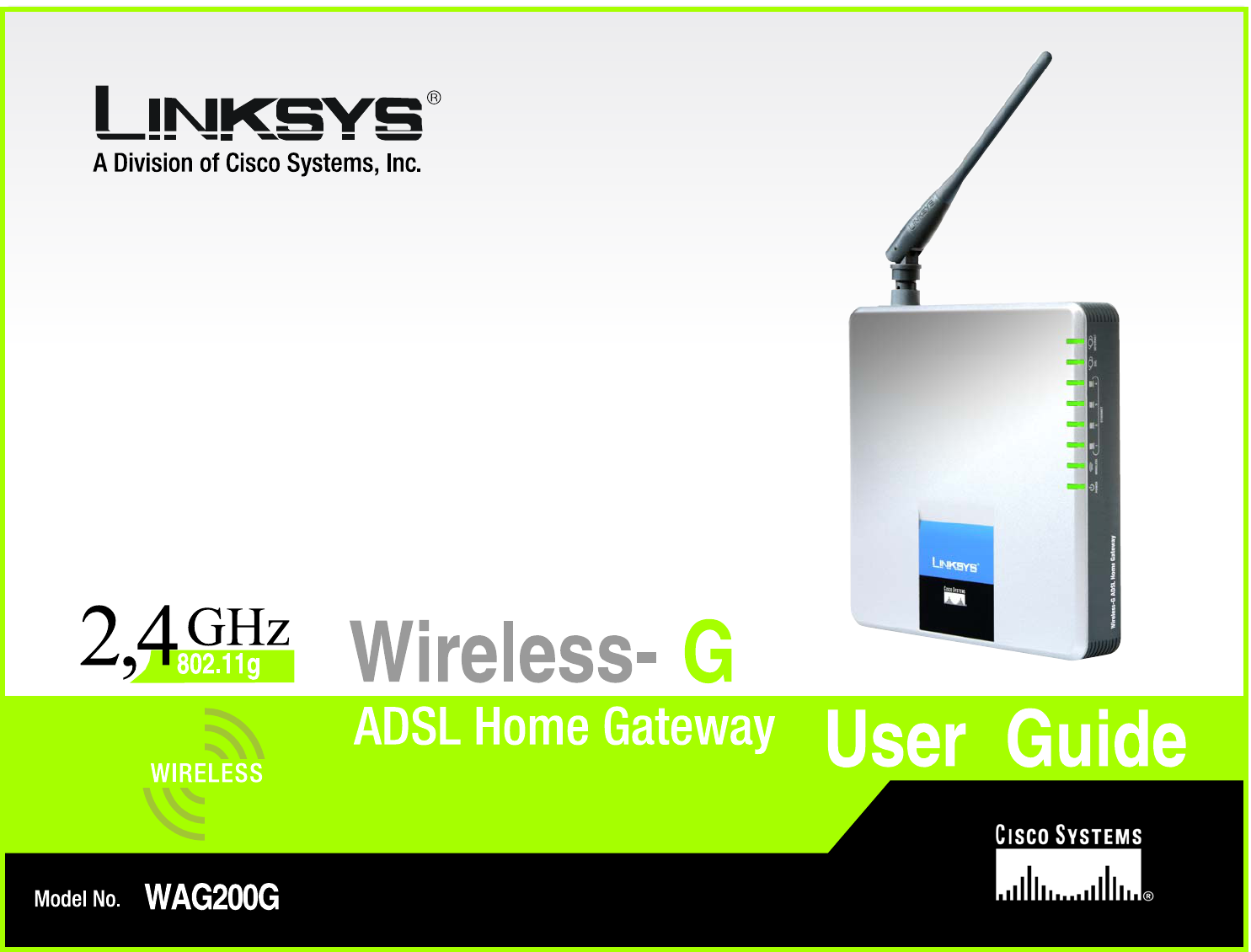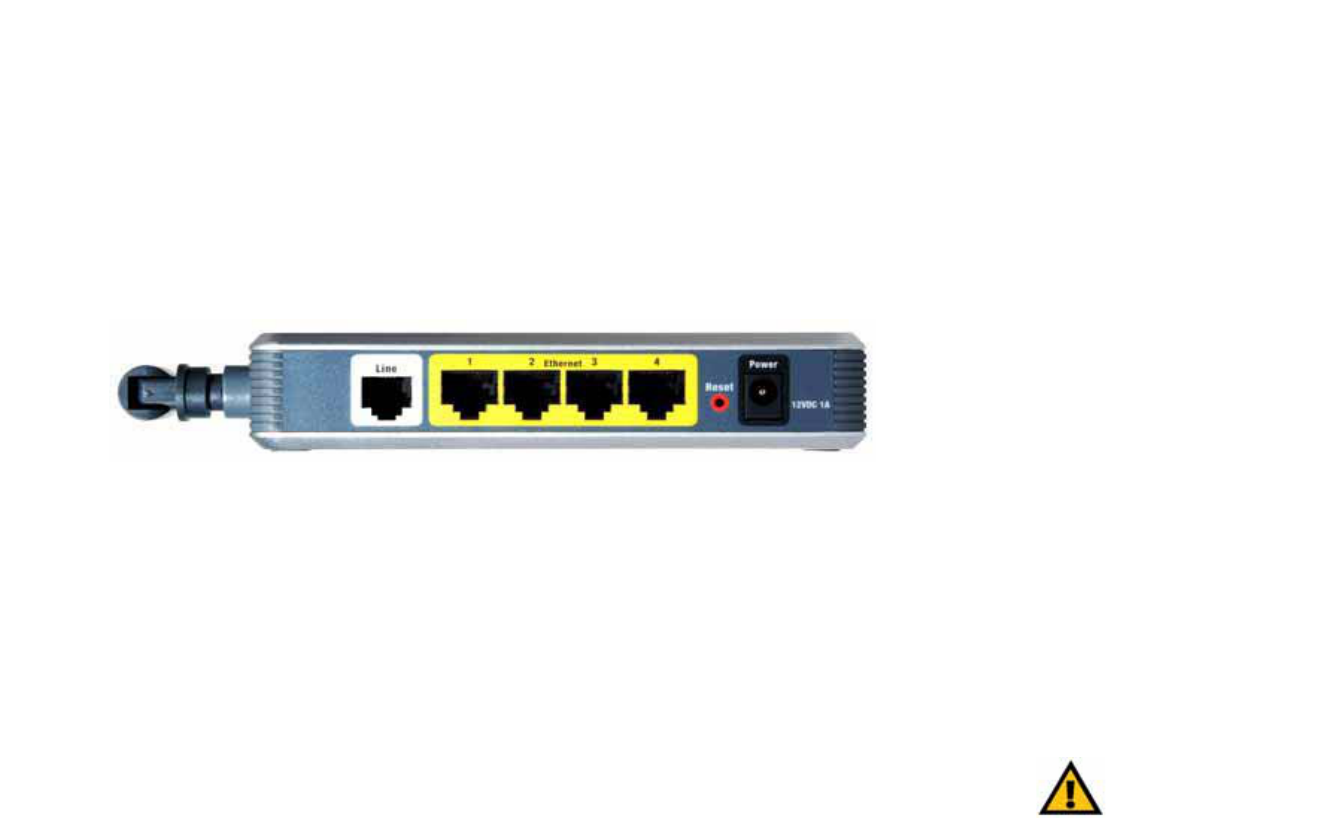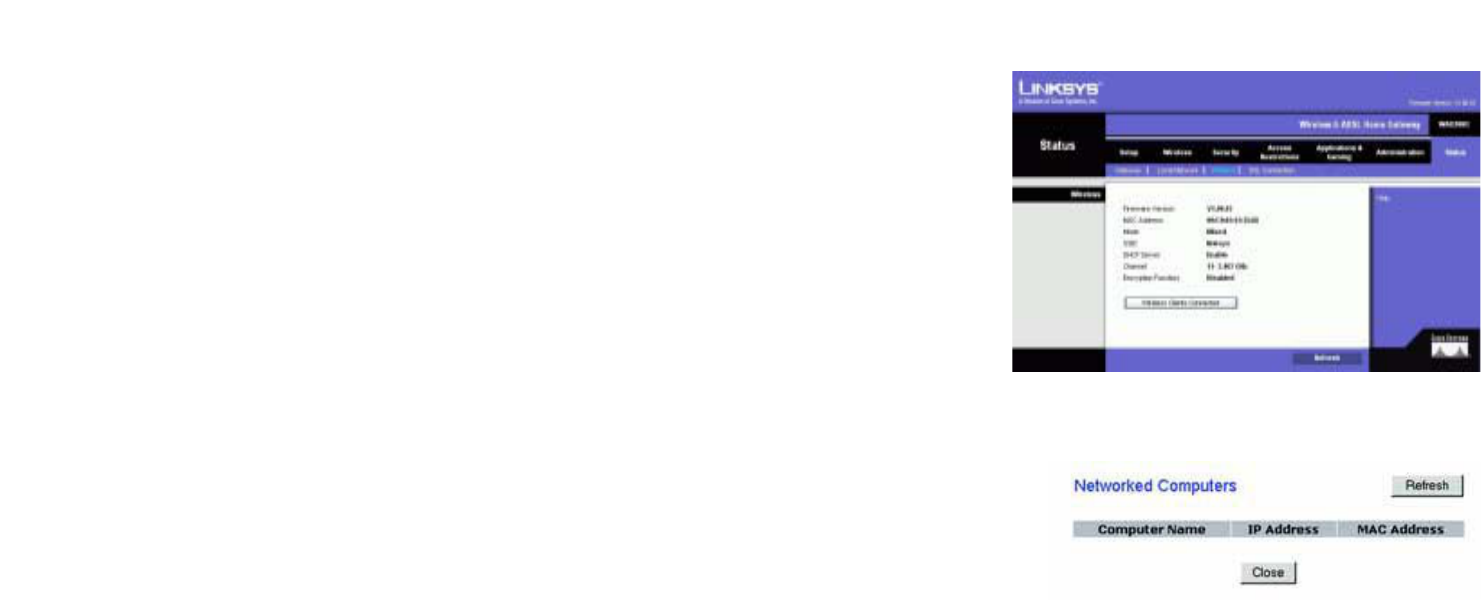LINKSYS WAG200G Wireless-G ADSL Home Gateway User Manual WAG200G User Man
LINKSYS LLC Wireless-G ADSL Home Gateway WAG200G User Man
LINKSYS >
Users Manual


Wireless-G ADSL Home Gateway
Copyright and Trademarks
Specifications are subject to change without notice. Linksys is a registered trademark or trademark of Cisco
Systems, Inc. and/or its affiliates in the U.S. and certain other countries. Copyright © 2005 Cisco Systems, Inc. All
rights reserved. Other brands and product names are trademarks or registered trademarks of their respective
holders.
How to Use this Guide
Your Guide to the Wireless-G ADSL Home Gateway has been designed to make understanding networking with
the Gateway easier than ever. Look for the following items when reading this User Guide:
In addition to these symbols, there are definitions for technical terms that are presented like this:
Also, each figure (diagram, screenshot, or other image) is provided with a figure number and description, like
this:
Figure numbers and descriptions can also be found in the “List of Figures” section in the “Table of Contents”.
This exclamation point means there is a Caution or
Warning and is something that could damage your
property or the Gateway.
word: definition.
This checkmark means there is a Note of interest and
is something you should pay special attention to while
using the Gateway.
This question mark provides you with a reminder about
something you might need to do while using the Gateway.
Figure 0-1: Sample Figure Description
WAG354G-EU-UG-50429C JL

Wireless-G ADSL Home Gateway
Table of Contents
Chapter 1: Introduction 1
Welcome 1
What’s in this User Guide? 2
Chapter 2: Planning Your Network 4
The Gateway’s Functions 4
IP Addresses 4
Chapter 3: Getting to Know the Wireless-G ADSL Home Gateway 6
Ports and Reset Button on Side Panel 6
LEDs on Side Panel 7
The Top Panel 8
The Bottom Panel 9
Chapter 4: Connecting the Wireless-G ADSL Home Gateway 10
Overview 10
Wired Connection to a Computer 11
Wireless Connection to a Computer 12
Chapter 5: Configuring the Wireless-G ADSL Home Gateway 13
Overview 13
How to Access the Web-based Utility 15
The Setup Tab 15
The Wireless Tab 23
The Security Tab 28
The Access Restrictions Tab 30
The Applications and Gaming Tab 32
The Administration Tab 37
The Status Tab 43
Appendix A: Troubleshooting 47
Common Problems and Solutions 47
Frequently Asked Questions 55
Appendix B: Wireless Security 62
Security Precautions 62
Security Threats Facing Wireless Networks 62

Wireless-G ADSL Home Gateway
Appendix C: Finding the MAC Address and IP Address for Your
Ethernet Adapter 65
Windows 98 or Me Instructions 65
Windows 2000 or XP Instructions 66
Appendix D: Upgrading Firmware 67
Appendix E: Glossary 68
Appendix F: Regulatory Information 75
Appendix G: Warranty Information 80
Appendix H: Specifications 81
Appendix I: Contact Information 83

Wireless-G ADSL Home Gateway
List of Figures
Figure 2-1: Network 4
Figure 3-1: Ports and Reset Button on Side Panel 6
Figure 3-2: LEDs on Side Panel 7
Figure 3-3: Top Panel 8
Figure 3-4: Top Panel with Optional Antenna 8
Figure 3-5: Bottom Panel with Stand in Closed Position 9
Figure 3-6: Gateway Using Stand 9
Figure 4-1: Connect the ADSL Line 11
Figure 4-2: Connect a PC 11
Figure 4-3: Connect the Power 11
Figure 4-4: Connect the ADSL Line 12
Figure 4-5: Connect the Power 12
Figure 5-1: Login Screen 15
Figure 5-2: Basic Setup 15
Figure 5-3: RFC 1483 Bridged - Dynamic IP 16
Figure 5-4: RFC 1483 Bridged - Static IP 16
Figure 5-5: RFC 1483 Routed 17
Figure 5-6: RFC 2516 PPPoE 17
Figure 5-7: RFC 2364 PPPoA 18
Figure 5-8: Bridged Mode Only 18
Figure 5-9: Optional Settings 19
Figure 5-10: DynDNS.org 20
Figure 5-11: TZO.com 20
Figure 5-12: Advanced Routing 21
Figure 5-13: Routing Table 22
Figure 5-14: Basic Wireless Settings 23
Figure 5-15: WPA Pre-Shared Key 24
Figure 5-16: WEP 25
Figure 5-17: Wireless Network Access 26
Figure 5-18: MAC Address Filter List 26
Figure 5-19: Wireless Client MAC List 26
Figure 5-20: Advanced Wireless Settings 27

Wireless-G ADSL Home Gateway
Figure 5-21: Security 28
Figure 5-22: Firewall Log 29
Figure 5-23: Internet Access 30
Figure 5-24: Internet Policy Summary 30
Figure 5-25: List of PCs 31
Figure 5-26: Add/Edit Service 31
Figure 5-27: Single Port Forwarding 32
Figure 5-28: Port Range Forwarding 33
Figure 5-29: Port Triggering 34
Figure 5-30: DMZ 35
Figure 5-31: QoS 36
Figure 5-32: Management 37
Figure 5-33: Allowed IP - IP Range 37
Figure 5-34: Reporting 39
Figure 5-35: System Log 39
Figure 5-36: Ping Test 40
Figure 5-37: Backup&Restore 40
Figure 5-38: Factory Defaults 41
Figure 5-39: Firmware Upgrade 41
Figure 5-40: Reboot 42
Figure 5-41: Gateway 43
Figure 5-42: Local Network 44
Figure 5-43: DHCP Active IP Table 44
Figure 5-44: ARP/RARP Table 44
Figure 5-45: Wireless 45
Figure 5-46: Networked Computers 45
Figure 5-47: DSL Connection 46
Figure C-1: IP Configuration Screen 65
Figure C-2: MAC Address/Adapter Address 65
Figure C-3: MAC Address/Physical Address 66
Figure D-1: Firmware Upgrade 67

1
Chapter 1: Introduction
Welcome
Wireless-G ADSL Home Gateway
Chapter 1: Introduction
Welcome
Thank you for choosing the Wireless-G ADSL Home Gateway. This Gateway will provide your computers with a
high-speed Internet connection as well as resources, including files and printers. Since the Gateway is wireless,
Internet access can be shared over the wired network as well as the wireless broadcast at up to 11Mbps for
Wireless-B or up to 54Mbps for Wireless-G.
How does the Gateway do all of this? By connecting the Internet, as well as your computers and peripherals, to
the Gateway, then the Gateway can direct and control communications for your network.
To protect your data and privacy, the Gateway features an advanced firewall to keep out Internet intruders.
Wireless transmissions can be protected by powerful data encryption. In addition, you can safeguard your family
with parental control features such as Internet access restrictions and keyword blocking. You can configure the
Gateway’s settings through the easy-to-use, browser-based utility.
But what does all of this mean?
Networks are useful tools for sharing Internet access and computer resources. You can access one printer from
different computers and access data located on another computer’s hard drive. Networks are even used for
playing multiplayer video games. So, networks not only are useful in homes and offices, but also can be fun.
PCs on a wired network create a LAN, or Local Area Network. They are connected with Ethernet cables, which is
why the network is called “wired”. PCs equipped with wireless cards or adapters can communicate without
cumbersome cables. By sharing the same wireless settings, within their transmission radius, they form a
wireless network. This is sometimes called a WLAN, or Wireless Local Area Network. Since the Gateway has
wireless capabilities, it can bridge your wired and wireless networks, letting them communicate with each other.
With your networks all connected, wired, wireless, and the Internet, you can now share files and Internet
access—and even play games. All the while, the Wireless-G ADSL Home Gateway protects your networks from
unauthorized and unwelcome users.
Linksys recommends using the Setup CD-ROM for first-time installation of the Gateway. If you do not wish to run
the Setup Wizard on the Setup CD-ROM, then use the instructions in this Guide to help you connect the Gateway,
set it up, and configure it to bridge your different networks. These instructions should be all you need to get the
most out of the Wireless-G ADSL Home Gateway.
lan (local area network): The computers and
networking products that make up the network in
your home or office.
nat (network address translation): NAT technology
translates IP addresses of a local area network to a
different IP address for the Internet.
wpa (wi-fi protected access): a wireless security
protocol using TKIP (Temporal Key Integrity Protocol)
encryption, which can be used in conjunction with a
RADIUS server.
spi (stateful packet inspection) firewall: a technology
that inspects incoming packets of information before
allowing them to enter the network.
firewall: Security measures that protect the
resources of a local network from intruders.
network: a series of computers or devices
connected for the purpose of data sharing,
storage, and/or transmission between users

2
Chapter 1: Introduction
What’s in this User Guide?
Wireless-G ADSL Home Gateway
What’s in this User Guide?
This user guide covers the steps for setting up and using the Wireless-G ADSL Home Gateway.
• Chapter 1: Introduction
This chapter describes applications of the Wireless-G ADSL Home Gateway and this User Guide.
• Chapter 2: Planning Your Network
This chapter describes the basics of networking.
• Chapter 3: Getting to Know the Wireless-G ADSL Home Gateway
This chapter describes the physical features of the Gateway.
• Chapter 4: Connecting the Wireless-G ADSL Home Gateway
This chapter instructs you on how to connect the Gateway to your network.
• Chapter 5: Configuring the Wireless-G ADSL Home Gateway
This chapter explains how to use the Web-based Utility to configure the settings on the Gateway.
• Appendix A: Troubleshooting
This appendix describes some problems and solutions, as well as frequently asked questions, regarding
installation and use of the Wireless-G ADSL Home Gateway.
• Appendix B: Wireless Security
This appendix explains the risks of wireless networking and some solutions to reduce the risks.
• Appendix C: Finding the MAC Address and IP Address for your Ethernet Adapter.
This appendix describes how to find the MAC address for your computer’s Ethernet adapter so you can use
the MAC filtering and/or MAC address cloning feature of the Gateway.
• Appendix D: Upgrading Firmware
This appendix instructs you on how to upgrade the firmware on the Gateway if you should need to do so.
• Appendix E: Glossary
This appendix gives a brief glossary of terms frequently used in networking.
• Appendix F: Specifications
This appendix provides the technical specifications for the Gateway.
• Appendix G: Warranty Information
This appendix supplies the warranty information for the Gateway.

3
Chapter 1: Introduction
What’s in this User Guide?
Wireless-G ADSL Home Gateway
• Appendix H: Regulatory Information
This appendix supplies the regulatory information regarding the Gateway.
• Appendix I: Contact Information
This appendix provides contact information for a variety of Linksys resources, including Technical Support.

4
Chapter 2: Planning Your Network
The Gateway’s Functions
Wireless-G ADSL Home Gateway
Chapter 2: Planning Your Network
The Gateway’s Functions
A Gateway is a network device that connects two networks together.
In this instance, the Gateway connects your Local Area Network (LAN), or the group of computers in your home or
office, to the Internet. The Gateway processes and regulates the data that travels between these two networks.
The Gateway’s NAT feature protects your network of computers so users on the public, Internet side cannot “see”
your computers. This is how your network remains private. The Gateway protects your network by inspecting
every packet coming in through the Internet port before delivery to the appropriate computer on your network.
The Gateway inspects Internet port services like the web server, ftp server, or other Internet applications, and, if
allowed, it will forward the packet to the appropriate computer on the LAN side.
Remember that the Gateway’s ports connect to two sides. The LAN ports connect to the LAN, and the ADSL port
connects to the Internet. The LAN ports transmit data at 10/100Mbps.
IP Addresses
What’s an IP Address?
IP stands for Internet Protocol. Every device on an IP-based network, including computers, print servers, and
Gateways, requires an IP address to identify its “location,” or address, on the network. This applies to both the
Internet and LAN connections. There are two ways of assigning an IP address to your network devices. You can
assign static IP addresses or use the Gateway to assign IP addresses dynamically.
Static IP Addresses
A static IP address is a fixed IP address that you assign manually to a computer or other device on the network.
Since a static IP address remains valid until you disable it, static IP addressing ensures that the device assigned
it will always have that same IP address until you change it. Static IP addresses must be unique and are
commonly used with network devices such as server computers or print servers.
NOTE: Since the Gateway is a device that connects
two networks, it needs two IP addresses—one for
the LAN, and one for the Internet. In this User Guide,
you’ll see references to the “Internet IP address”
and the “LAN IP address.”
Since the Gateway uses NAT technology, the only IP
address that can be seen from the Internet for your
network is the Gateway’s Internet IP address.
However, even this Internet IP address can be
blocked, so that the Gateway and network seem
invisible to the Internet—see the Block WAN
Requests description under Security in “Chapter 5:
Configuring the Wireless-G ADSL Home Gateway.”
Figure 2-1: Network
ip (internet protocol): a protocol used to send data
over a network

5
Chapter 2: Planning Your Network
IP Addresses
Wireless-G ADSL Home Gateway
Since you use the Gateway to share your DSL Internet connection, contact your ISP to find out if they have
assigned a static IP address to your account. If so, you will need that static IP address when configuring the
Gateway. You can get that information from your ISP.
Dynamic IP Addresses
A dynamic IP address is automatically assigned to a device on the network, such as computers and print servers.
These IP addresses are called “dynamic” because they are only temporarily assigned to the computer or device.
After a certain time period, they expire and may change. If a computer logs onto the network (or the Internet) and
its dynamic IP address has expired, the DHCP server will automatically assign it a new dynamic IP address.
DHCP (Dynamic Host Configuration Protocol) Servers
Computers and other network devices using dynamic IP addressing are assigned a new IP address by a DHCP
server. The computer or network device obtaining an IP address is called the DHCP client. DHCP frees you from
having to assign IP addresses manually every time a new user is added to your network.
A DHCP server can either be a designated computer on the network or another network device, such as the
Gateway. By default, the Gateway’s DHCP Server function is enabled.
If you already have a DHCP server running on your network, you must disable one of the two DHCP servers. If you
run more than one DHCP server on your network, you will experience network errors, such as conflicting IP
addresses. To disable DHCP on the Gateway, see the DHCP section in “Chapter 5: Configuring the Wireless-G
ADSL Home Gateway.”

6
Chapter 3: Getting to Know the Wireless-G ADSL Home Gateway
Ports and Reset Button on Side Panel
Wireless-G ADSL Home Gateway
Chapter 3: Getting to Know the Wireless-G ADSL Home
Gateway
Ports and Reset Button on Side Panel
The Gateway’s ports and Reset button are located on a side panel.
Line The Line port connects to the ADSL line.
Ethernet (1-4) The Ethernet ports connect to your computers and other network devices.
Reset Button There are two ways to reset the Gateway's factory defaults. Either press the Reset Button, for
approximately ten seconds, or restore the defaults from the
Factory Defaults
screen of the
Administration tab in the Gateway’s Web-based Utility.
Power The Power port is where you will connect the power adapter.
IMPORTANT: Resetting the Gateway to factory
defaults will erase all of your settings
(including Internet connection, wireless, and
other settings) and replace them with the
factory defaults. Do not reset the Gateway if
you want to retain these settings.
Figure 3-1: Ports and Reset Button on Side Panel

7
Chapter 3: Getting to Know the Wireless-G ADSL Home Gateway
LEDs on Side Panel
Wireless-G ADSL Home Gateway
LEDs on Side Panel
The Gateway's LEDs, which indicate network activity, are located on the other side panel.
POWER Green. The POWER LED lights up when the Gateway is powered on.
WIRELESS Green. The WIRELESS LED lights up whenever there is a successful wireless connection. If the
LED is flashing, the Gateway is actively sending or receiving data to or from one of the devices
on the network.
ETHERNET (1-4) Green. The ETHERNET LED serves two purposes. If the LED is continuously lit, the Gateway is
successfully connected to a device through the LAN port. If the LED is flashing, it is an
indication of any network activity.
DSL Green. The DSL LED lights up whenever there is a successful DSL connection. The LED blinks
while the Gateway is establishing the ADSL connection.
INTERNET Green. The INTERNET LED lights up green when an Internet connection to the Internet Service
Provider (ISP) is established. The INTERNET LED lights up red when the connection to the ISP
fails.
Figure 3-2: LEDs on Side Panel

10
Chapter 4: Connecting the Wireless-G ADSL Home Gateway
Overview
Wireless-G ADSL Home Gateway
Chapter 4: Connecting the Wireless-G ADSL Home Gateway
Overview
The installation technician from your ISP should have left the setup information for the modem with you after
installing your broadband connection. If not, you can call your ISP to request that data.
After you have the setup information you need for your specific type of Internet connection, you can begin
installation and setup of the Gateway.
If you want to use a computer with an Ethernet adapter to configure the Gateway, continue to “Wired Connection
to a Computer.” If you want to use a computer with a wireless adapter to configure the Gateway, continue to
“Wireless Connection to a Computer.”

10
Chapter 4: Connecting the Wireless-G ADSL Home Gateway
Overview
Wireless-G ADSL Home Gateway
Chapter 4: Connecting the Wireless-G ADSL Home
Gateway
Overview
The installation technician from your ISP should have left the setup information for the modem with you after
installing your broadband connection. If not, you can call your ISP to request that data.
After you have the setup information you need for your specific type of Internet connection, you can begin
installation and setup of the Gateway.
If you want to use a computer with an Ethernet adapter to configure the Gateway, continue to “Wired Connection
to a Computer.” If you want to use a computer with a wireless adapter to configure the Gateway, continue to
“Wireless Connection to a Computer.”

11
Chapter 4: Connecting the Wireless-G ADSL Home Gateway
Wired Connection to a Computer
Wireless-G ADSL Home Gateway
Wired Connection to a Computer
1. Make sure that all of your network’s hardware is powered off, including the Gateway and all computers.
2. Connect a phone cable from the Line port on the Gateway’s side panel to the wall jack of the ADSL line. A
small device called a microfilter (not included) may be necessary between each phone and wall jack to
prevent interference. Contact your ISP if you have any questions.
3. Connect one end of an Ethernet network cable to one of the Ethernet ports (labeled 1-4) on the back of the
Gateway, and the other end to an Ethernet port on a computer.
Repeat this step to connect more computers, a switch, or other network devices to the Gateway.
4. Connect the power adapter to the Gateway’s Power port, and then plug the power adapter into a power outlet.
The Power LED on the front panel will light up green as soon as the power adapter is connected properly. The
Power LED will flash for a few seconds, and then it will be solidly lit when the self-test is complete. If the LED
flashes for one minute or longer, see “Appendix A: Troubleshooting.”
5. Power on one of your computers that is connected to the Gateway.
Go to “Chapter 5: Configuring the Wireless-G ADSL Home Gateway.”
ADSL Line
Figure 4-1: Connect the
Figure 4-2: Connect a PC
NOTE: You should always plug the Gateway’s power adapter into a power strip with
surge protection.
IMPORTANT: For countries that have phone jacks with RJ-11 connectors, make sure to only place
the microfilters between the phone and the wall jack and not between the Gateway and the wall
jack or your ADSL will not connect.
For countries that do not have phone jacks with RJ-11 connectors (e.g. France, Sweden,
Switzerland, United Kingdom, etc.), except for ISDN users, the microfilter has to be used between
the Gateway and the wall jack, because the microfilter will have the RJ-11 connector.
Annex B users (E1 and DE versions of the Gateway) must use the included special cable to connect
the Gateway to the wall jack (RJ-45 to RJ-12). If you require splitters or special jacks, please
contact your service provider.
NOTE:
A small device called a microfilter (not included) may be necessary between each phone
and wall jack to prevent interference. Contact your ISP if you have any questions.

12
Chapter 4: Connecting the Wireless-G ADSL Home Gateway
Wireless Connection to a Computer
Wireless-G ADSL Home Gateway
Wireless Connection to a Computer
If you want to use a wireless connection to access the Gateway, follow these instructions:
1. Make sure that all of your network’s hardware is powered off, including the Gateway and all computers.
2. Connect a phone cable from the Line port on the Gateway’s back panel to the wall jack of the ADSL line. A
small device called a microfilter (not included) may be necessary between each phone and wall jack to
prevent interference. Contact your ISP if you have any questions.
3. Connect the power adapter to the Power port, and then plug the power adapter into a power outlet.
The Power LED on the front panel will light up green as soon as the power adapter is connected properly. The
Power LED will flash for a few seconds, and then it will be solidly lit when the self-test is complete. If the LED
flashes for one minute or longer, see “Appendix A: Troubleshooting.”
4. Power on one of the computers on your wireless network(s).
5. For initial access to the Gateway through a wireless connection, make sure the computer’s wireless adapter
has its SSID set to linksys (the Gateway’s default setting), and its wireless security is disabled. After you have
accessed the Gateway, you can change the Gateway and this computer’s adapter settings to match your usual
network settings.
Go to “Chapter 5: Configuring the Wireless-G ADSL Home Gateway.” NOTE: You should always change the SSID from its
default, linksys, and enable wireless security.
NOTE:
A small device called a microfilter (not included) may be necessary between each phone
and wall jack to prevent interference. Contact your ISP if you have any questions.
IMPORTANT: For countries that have phone jacks with RJ-11 connectors, make sure you only place
the microfilters between the phone and the wall jack and not between the Gateway and the wall jack
or your ADSL will not connect.
For countries that do not have phone jacks with RJ-11 connectors (e.g. France, Sweden, Switzerland,
United Kingdom, etc.), except for ISDN users, the microfilter has to be used between the Gateway and
the wall jack, because the microfilter will have the RJ-11 connector.
Annex B users (E1 and DE versions of the Gateway) must use the included special cable to connect
the Gateway to the wall jack (RJ-45 to RJ-12). If you require splitters or special jacks, please contact
your service provider.
Figure 4-3: Connect the
Power

13
Chapter 5: Configuring the Wireless-G ADSL Home Gateway
Overview
Wireless-G ADSL Home Gateway
Chapter 5: Configuring the Wireless-G ADSL Home
Gateway
Overview
Follow the steps in this chapter and use the Gateway’s web-based utility to configure the Gateway. This chapter
will describe each web page in the Utility and each page’s key functions. The utility can be accessed via your web
browser through use of a computer connected to the Gateway. For a basic network setup, most users only have to
use the following screens of the Utility:
• Basic Setup. On the Basic Setup screen, enter the settings provided by your ISP.
• Management. Click the Administration tab and then the Management tab. The Gateway’s default username
and password is admin. To secure the Gateway, change the Password from its default.
There are seven main tabs: Setup, Wireless, Security, Access Restrictions, Applications & Gaming, Administration,
and Status. Additional tabs will be available after you click one of the main tabs.
Setup
• Basic Setup. Enter the Internet connection and network settings on this screen.
• DDNS. To enable the Gateway’s Dynamic Domain Name System (DDNS) feature, complete the fields on this
screen.
• Advanced Routing. On this screen, you can alter NAT and routing configurations.
Wireless
• Basic Wireless Settings. You can choose your wireless network settings on this screen.
• Wireless Security. Configure your wireless security settings on this screen.
• Wireless Access. This screen lets you control access to your wireless network.
• Advanced Wireless Settings. On this screen you can access the advanced wireless network settings.
NOTE: For added security, you should change
the password through the Administration tab.
HAVE YOU: Enabled TCP/IP on your
computers? Computers communicate over the
network with this protocol. Refer to Windows
Help for more information on TCP/IP.

14
Chapter 5: Configuring the Wireless-G ADSL Home Gateway
Overview
Wireless-G ADSL Home Gateway
Security
On this screen you can disable or enable the firewall, set up filters, block WAN requests, and enable or disable
Virtual Private Networks (VPN) PassThrough.
Access Restrictions
• Internet Access. This screen allows you to control the Internet usage and traffic on your local network.
Applications & Gaming
• Single Port Forwarding. Use this screen to set up common services or applications that require forwarding on
a single port.
• Port Range Forwarding. To set up public services or other specialized Internet applications that require
forwarding on a range of ports, use this screen.
• Port Triggering. To set up triggered ranges and forwarded ranges for Internet applications, click this tab.
• DMZ. To allow one local computer to be exposed to the Internet for use of special-purpose services, use this
screen.
• QoS. Use Quality of Service (QoS) to assign different priority levels to different types of data transmissions.
Administration
• Management. On this screen, alter Gateway access, Simple Network Management Protocol (SNMP), Universal
Plug and Play (UPnP), IGMP-Proxy (IGMP stands for Internet Group Multicast Protocol), and wireless
management settings.
• Reporting. If you want to view or save activity logs, click this tab.
• Diagnostics. Use this screen to run a Ping test.
• Backup&Restore. On this screen, you can back up or restore the Gateway’s configuration.
• Factory Defaults. If you want to restore the Gateway’s factory default settings, use this screen.
• Firmware Upgrade. Click this tab if you want to upgrade the Gateway’s firmware.
• Reboot. If you need to do a hard or soft reboot of the Gateway, use this screen.
vpn (virtual private network): a security measure
to protect data as it leaves one network and
goes to another over the Internet.

15
Chapter 5: Configuring the Wireless-G ADSL Home Gateway
How to Access the Web-based Utility
Wireless-G ADSL Home Gateway
Status
• Gateway. This screen provides status information about the Gateway.
• Local Network. This provides status information about the local network.
• Wireless. This screen provides status information about the wireless network.
• DSL Connection. This screen provides status information about the DSL connection.
How to Access the Web-based Utility
To access the web-based utility, launch Internet Explorer or Netscape Navigator, and enter the Gateway’s default
IP address, 192.168.1.1, in the
Address
field. Then press Enter.
A login screen will appear (Windows XP users will see a similar screen). Enter admin (the default user name) in
the
User Name
field, and enter admin (the default password) in the
Password
field. Then click the OK button.
The Setup Tab
The Basic Setup Tab
The first screen that appears is the Basic Setup tab. This tab allows you to change the Gateway's general
settings. Change these settings as described here and click the Save Settings button to save your changes, or
click the Cancel Changes button to cancel your changes.
Internet Setup
• Internet Connection Type. The Gateway supports five Encapsulation methods: RFC 1483 Bridged, RFC 1483
Routed, RFC 2516 PPPoE, RFC 2364 PPPoA, and Bridged Mode Only. Select the appropriate type of
encapsulation from the drop-down menu. Each
Basic Setup
screen and available features will differ
depending on what type of encapsulation you select.
• VC Settings. You will configure your Virtual Circuit (VC) settings in this section.
• Multiplexing: Select LLC or VC, depending on your ISP.
• QoS Type: Select from the drop-down menu: CBR (Continuous Bit Rate) to specify fixed bandwidth for
voice or data traffic; UBR (Unspecific Bit Rate) for application that are none-time sensitive, such as e-mail;
or VBR (Variable Bite Rate) for Bursty traffic and bandwidth-sharing with other applications. Figure 5-2: Basic Setup
Figure 5-1: Login Screen

16
Chapter 5: Configuring the Wireless-G ADSL Home Gateway
The Setup Tab
Wireless-G ADSL Home Gateway
• Pcr Rate: For the Peak Cell Rate, divide the DSL line rate by 424 to get the maximum rate the sender can
send cells. Enter the rate in the field (if required by your service provider).
• Scr Rate: The Sustain Cell Rate sets the average cell rate that can be transmitted. The SCR value is
normally less than the PCR value. Enter the rate in the field (if required by your service provider).
• Autodetect: Select Enable to have the settings automatically entered, or select Disable to enter the values
manually.
• Virtual Circuit: These fields consist of two items: VPI (Virtual Path Identifier) and VCI (Virtual Channel
Identifier). Your ISP will provide the correct settings for these fields.
• IP Settings. Follow the instructions in the section for your type of encapsulation.
RFC 1483 Bridged
Dynamic IP
IP Settings. Select Obtain an IP Address Automatically if your ISP says you are connecting through a dynamic
IP address.
Static IP
If you are required to use a permanent (static) IP address to connect to the Internet, then select Use the
following IP Address.
• Internet IP Address. This is the Gateway’s IP address, when seen from the WAN, or the Internet. Your ISP
will provide you with the IP Address you need to specify here.
• Subnet Mask. This is the Gateway’s Subnet Mask. Your ISP will provide you with the Subnet Mask.
• Gateway. Your ISP will provide you with the default Gateway Address, which is the ISP server’s IP address.
• Primary DNS (Required) and Secondary DNS (Optional). Your ISP will provide you with at least one DNS
(Domain Name System) Server IP Address.
Figure 5-3: RFC 1483 Bridged - Dynamic IP
Figure 5-4: RFC 1483 Bridged - Static IP

17
Chapter 5: Configuring the Wireless-G ADSL Home Gateway
The Setup Tab
Wireless-G ADSL Home Gateway
RFC 1483 Routed
If you are required to use RFC 1483 Routed, then select RFC 1483 Routed.
• Internet IP Address. This is the Gateway’s IP address, when seen from the WAN, or the Internet. Your ISP
will provide you with the IP Address you need to specify here.
• Subnet Mask. This is the Gateway’s Subnet Mask. Your ISP will provide you with the Subnet Mask.
• Gateway. Your ISP will provide you with the default Gateway Address, which is the ISP server’s IP address.
• Primary DNS (Required) and Secondary DNS (Optional). Your ISP will provide you with at least one DNS
(Domain Name System) Server IP Address.
RFC 2516 PPPoE
Some DSL-based ISPs use PPPoE (Point-to-Point Protocol over Ethernet) to establish Internet connections. If
you are connected to the Internet through a DSL line, check with your ISP to see if they use PPPoE. If they do,
you will have to enable PPPoE.
• Service Name. Enter the name of your PPPoE service in this field.
• User Name and Password. Enter the User Name and Password provided by your ISP.
• Connect on Demand: Max Idle Time. You can configure the Gateway to disconnect the Internet connection
after it has been inactive for a specified period of time (Max Idle Time). If your Internet connection has
been terminated due to inactivity, Connect on Demand enables the Gateway to automatically re-establish
your connection as soon as you attempt to access the Internet again. To use this option, click the Connect
on Demand radio button. In the
Max Idle Time
field, enter the number of minutes you want to have elapsed
before your Internet connection terminates.
• Keep Alive: Redial Period. If you select this option, the Gateway will periodically check your Internet
connection. If you are disconnected, then the Gateway will automatically re-establish your connection. To
use this option, click the Keep Alive radio button. In the
Redial Period
field, specify how often you want the
Gateway to check the Internet connection. The default Redial Period is 20 seconds.
Figure 5-5: RFC 1483 Routed
Figure 5-6: RFC 2516 PPPoE

18
Chapter 5: Configuring the Wireless-G ADSL Home Gateway
The Setup Tab
Wireless-G ADSL Home Gateway
RFC 2364 PPPoA
Some DSL-based ISPs use PPPoA (Point-to-Point Protocol over ATM) to establish Internet connections. If you
are connected to the Internet through a DSL line, check with your ISP to see if they use PPPoA. If they do, you
will have to enable PPPoA.
• User Name and Password. Enter the User Name and Password provided by your ISP.
• Connect on Demand: Max Idle Time. You can configure the Gateway to disconnect the Internet connection
after it has been inactive for a specified period of time (Max Idle Time). If your Internet connection has
been terminated due to inactivity, Connect on Demand enables the Gateway to automatically re-establish
your connection as soon as you attempt to access the Internet again. To use this option, click the Connect
on Demand radio button. In the
Max Idle Time
field, enter the number of minutes you want to have elapsed
before your Internet connection terminates.
• Keep Alive: Redial Period. If you select this option, the Gateway will periodically check your Internet
connection. If you are disconnected, then the Gateway will automatically re-establish your connection. To
use this option, click the Keep Alive radio button. In the
Redial Period
field, specify how often you want the
Gateway to check the Internet connection. The default Redial Period is 20 seconds.
Bridged Mode Only
If you are using your Gateway as a bridge, which makes the Gateway act like a stand-alone modem, select
Bridged Mode Only. All NAT and routing settings are disabled in this mode.
Optional Settings (required by some ISPs)
• Host Name and Domain Name. These fields allow you to supply a host and domain name for the Gateway.
Some ISPs require these names as identification. You may have to check with your ISP to see if your
broadband Internet service has been configured with a host and domain name. In most cases, you can leave
these fields blank.
• MTU and Size. The MTU (Maximum Transmission Unit) setting specifies the largest packet size permitted for
network transmission. Select Manual and enter the value desired in the
Size
field. It is recommended that you
leave this value in the 1200 to 1500 range. By default, MTU is configured automatically.
Network Setup
• Router IP. The values for the Gateway’s Local IP Address and Subnet Mask are shown here. In most cases,
keeping the default values will work.
Figure 5-7: RFC 2364 PPPoA
Figure 5-8: Bridged Mode Only

19
Chapter 5: Configuring the Wireless-G ADSL Home Gateway
The Setup Tab
Wireless-G ADSL Home Gateway
• Local IP Address. The default value is 192.168.1.1.
• Subnet Mask. The default value is 255.255.255.0.
• Network Address Server Settings (DHCP). Configure the Gateway’s Dynamic Host Configuration Protocol
(DHCP) settings in this section.
• Local DHCP Server. A Dynamic Host Configuration Protocol (DHCP) server automatically assigns an IP
address to each computer on your network for you. Unless you already have one, it is highly
recommended that you leave the Gateway enabled as a DHCP server. You can also use the Gateway in
DHCP Relay mode.
• DHCP Relay Server. If you enable the DHCP Relay mode for the
Local DHCP Server
setting, enter the IP
address for the DHCP server in the fields provided.
• Starting IP Address. Enter a value for the DHCP server to start with when issuing IP addresses. This value
must be 192.168.1. 2 or greater, because the default IP address for the Gateway is 192.168.1.1.
• Maximum Number of DHCP Users. Enter the maximum number of users/clients that can obtain an IP
address. The number will vary depending on the starting IP address entered.
• Client Lease Time. The Client Lease Time is the amount of time a computer will be allowed connection to
the Gateway with its current dynamic IP address. Enter the amount of time, in minutes, that the computer
will be “leased” this dynamic IP address.
• Static DNS 1-3. The Domain Name System (DNS) is how the Internet translates domain or website names
into Internet addresses or URLs. Your ISP will provide you with at least one DNS Server IP Address. You
can enter up to three DNS Server IP Addresses here. The Gateway will use these for quicker access to
functioning DNS servers.
• WINS. The Windows Internet Naming Service (WINS) converts NetBIOS names to IP addresses. If you use a
WINS server, enter that server’s IP address here. Otherwise, leave this field blank.
• Time Setting. Select the appropriate time zone for the Gateway’s location. If desired, check the
Automatically adjust clock for daylight saving changes checkbox.
When finished making your changes on this tab, click the Save Settings button to save these changes, or click the
Cancel Changes button to undo your changes.
Figure 5-9: Optional Settings

20
Chapter 5: Configuring the Wireless-G ADSL Home Gateway
The Setup Tab
Wireless-G ADSL Home Gateway
The DDNS Tab
The Gateway offers a Dynamic Domain Name System (DDNS) feature. DDNS lets you assign a fixed host and
domain name to a dynamic Internet IP address. It is useful when you are hosting your own website, FTP server, or
other server behind the Gateway.
Before you can use this feature, you need to sign up for DDNS service at DynDNS.org or TZO.com.
DDNS
DDNS Service. If your DDNS service is provided by DynDNS.org, then select DynDNS.org from the drop-down
menu. If your DDNS service is provided by TZO.com, then select TZO.com from the drop-down menu.To disable
DDNS Service, select Disabled.
DynDNS.org
• User Name, Password, and Host Name. Enter the User Name, Password, and Host Name of the account you
set up with DynDNS.org.
• Internet IP Address. The Gateway’s current Internet IP Address is displayed here. Because it is dynamic, it will
change.
• Status. The status of the DDNS service connection is displayed here.
TZO.com
• E-mail Address, Password, and Domain Name. Enter the E-mail Address, Password, and Domain Name of the
account you set up with TZO.
• Internet IP Address. The Gateway’s current Internet IP Address is displayed here. Because it is dynamic, this
will change.
• Status. The status of the DDNS service connection is displayed here.
When finished making your changes on this tab, click the Save Settings button to save these changes, or click the
Cancel Changes button to undo your changes.
Figure 5-10: DynDNS.org
Figure 5-11: TZO.com

21
Chapter 5: Configuring the Wireless-G ADSL Home Gateway
The Setup Tab
Wireless-G ADSL Home Gateway
The Advanced Routing Tab
The
Advanced Routing
screen allows you to configure the NAT, dynamic routing, and static routing settings.
Advanced Routing
• Operating Mode. In this section, you will configure the Gateway’s general routing settings.
• NAT. NAT is a security feature that is enabled by default. It enables the Gateway to translate IP addresses
of your local area network to a different IP address for the Internet. To disable NAT, click the Disabled
radio button.
• RIP. If you have multiple routers, you may want to use the Routing Information Protocol (RIP) so the routers
can exchange routing information with each other. To use RIP, select the Enabled radio button. Otherwise,
keep the default, Disabled.
• Send Default Route. To use RIP version 1 for routing, select the Enabled radio button. Otherwise, keep the
default, Disabled.
• Interface. This setting is available when you have configured a static route and you need to choose an
interface for that route. Select the interface that the Gateway will be using: LAN/Wireless or Internet.
• Dynamic Routing. With Dynamic Routing you can enable the Gateway to automatically adjust to physical
changes in the network’s layout. Using RIP, the Gateway determines the network packets’ route based on the
fewest number of hops between the source and the destination. The RIP protocol regularly broadcasts routing
information to other Gateways on the network.
• Transmit RIP Version. To transmit RIP messages, select the protocol you want: RIP1, RIP1-Compatible, or
RIP2. If you don’t want to transmit RIP messages, select None.
• Receive RIP Version. To receive RIP messages, select the protocol you want: RIP1 or RIP2. If you don’t
want to receive RIP messages, select None.
• Multicast or Broadcast. RIP can be sent using either methods. If you want to use multicasting, select
Multicast. If you want to use Broadcast, select Broadcast.
• Static Routing. If the Gateway is connected to more than one network, it may be necessary to set up a static
route between them. A static route is a pre-determined pathway that network information must travel to
reach a specific host or network. To create a static route, change the following settings:
Figure5-12:AdvancedRouting

22
Chapter 5: Configuring the Wireless-G ADSL Home Gateway
The Setup Tab
Wireless-G ADSL Home Gateway
• Select set number. Select the number of the static route from the drop-down menu. The Gateway
supports up to 20 static route entries. If you need to delete a route, then select the entry and click the
Delete This Entry button.
• Destination IP Address. The Destination IP Address is the address of the remote network or host to which
you want to assign a static route. Enter the IP address of the host for which you wish to create a static
route. If you are building a route to an entire network, be sure that the network portion of the IP address is
set to 0.
• Subnet Mask. Enter the Subnet Mask (also known as the Network Mask), which determines which portion
of an IP address is the network portion, and which portion is the host portion.
• Gateway. Enter the IP address of the gateway device that allows for contact between the Gateway and the
remote network or host.
• Hop Count. Hop Count is the number of hops to each node until the destination is reached (16 hops
maximum). Enter the Hop Count in the field provided.
• Show Routing Table. Click the Show Routing Table button to open a screen displaying how data is routed
through your local network. For each route, the Destination LAN IP address, Subnet Mask, Gateway, and
Interface are displayed. Click the Refresh button to update the information. Click the Close button to return to
the previous screen.
When finished making your changes on this tab, click the Save Settings button to save these changes, or click the
Cancel Changes button to undo your changes.
Figure 5-13: Routing Table

23
Chapter 5: Configuring the Wireless-G ADSL Home Gateway
The Wireless Tab
Wireless-G ADSL Home Gateway
The Wireless Tab
The Basic Wireless Settings Tab
This screen allows you to choose your wireless network mode and wireless security.
Wireless Network
• Wireless Network Mode. If you have 802.11g and 802.11b devices in your network, then keep the default
setting, Mixed. If you have only 802.11g devices, select 802.11g. If you have only 802.11b devices, select
802.11b. If you want to disable wireless networking, select Disabled.
• Wireless Network Name (SSID). Enter the name for your wireless network into the field. The SSID is the
network name shared among all devices in a wireless network. It must be identical for all devices in the
wireless network. It is case-sensitive and must not exceed 32 alphanumeric characters, which may be any
keyboard character. Linksys recommends that you change the default SSID (linksys) to a unique name of your
choice.
• Wireless Channel. Select the appropriate channel from the list provided to correspond with your network
settings. All devices in your wireless network must use the same channel in order to function correctly.
Wireless computers or clients will automatically detect the wireless channel of the Gateway.
• Wireless SSID Broadcast. When wireless computers or clients survey the local area for wireless networks to
associate with, they will detect the SSID broadcast by the Gateway. To broadcast the Gateway's SSID, keep
the default setting, Enable. If you do not want to broadcast the Gateway's SSID, then select Disable.
When finished making your changes on this tab, click the Save Settings button to save these changes, or click the
Cancel Changes button to undo your changes.
Figure 5-14: Basic Wireless Settings

24
Chapter 5: Configuring the Wireless-G ADSL Home Gateway
The Wireless Tab
Wireless-G ADSL Home Gateway
The Wireless Security Tab
The Wireless Security settings configure the security of your wireless network. There are two wireless security
options supported by the Gateway: WPA Personal and WEP. (WPA stands for Wi-Fi Protected Access, which is a
security standard stronger than WEP encryption. WEP stands for Wired Equivalent Privacy.) These are briefly
discussed here. For detailed instructions on configuring wireless security for the Gateway, turn to “Appendix B:
Wireless Security.” If you want to disable wireless security, select Disable from the drop-down menu for Security
Mode.
WPA Personal. Enter a WPA Personal of 8-32 characters. Then enter a Group Key Renewal period, which instructs
the Gateway how often it should change the encryption keys. Figure 5-15: WPA Personal

25
Chapter 5: Configuring the Wireless-G ADSL Home Gateway
The Wireless Tab
Wireless-G ADSL Home Gateway
WEP. WEP is a basic encryption method, which is not as secure as WPA. To use WEP, select a Default Key (this
indicates which Key to use) and a level of WEP encryption, 64 bits 10 hex digits or 128 bits 26 hex digits. Then
either generate a WEP key using a Passphrase or enter the WEP key manually.
• WEP Encryption. An acronym for Wired Equivalent Privacy, WEP is an encryption method used to protect your
wireless data communications. WEP uses 64-bit or 128-bit keys to provide access control to your network
and encryption security for every data transmission. To decode data transmissions, all devices in a network
must use an identical WEP key. Higher encryption levels offer higher levels of security, but due to the
complexity of the encryption, they may decrease network performance. To enable WEP, select 64 bits 10 hex
digits or 128 bits 26 hex digits.
• Default Transmit Key Select which WEP key (1-4) will be used when the Gateway sends data. Make sure that
the receiving device (wireless computer or client) is using the same key.
• Passphrase. Instead of manually entering WEP keys, you can enter a passphrase. This passphrase is used to
generate one or more WEP keys. It is case-sensitive and should not be longer than 32 alphanumeric
characters. (This Passphrase function is compatible with Linksys wireless products only and cannot be used
with Windows XP Zero Configuration. If you want to communicate with non-Linksys wireless products or
Windows XP Zero Configuration, make a note of the WEP key generated in the
Key 1
field, and enter it
manually in the wireless computer or client.) After you enter the Passphrase, click the Generate button to
create WEP keys.
• WEP Keys 1-4. WEP keys enable you to create an encryption scheme for wireless network transmissions. If
you are not using a Passphrase, then manually enter a set of values. (Do not leave a key field blank, and do
not enter all zeroes; they are not valid key values.) If you are using 64-bit WEP encryption, the key must be
exactly 10 hexadecimal characters in length. If you are using 128-bit WEP encryption, the key must be exactly
26 hexadecimal characters in length. Valid hexadecimal characters are “0”-“9” and “A”-“F”.
When finished making your changes on this tab, click the Save Settings button to save these changes, or click the
Cancel Changes button to undo your changes. For detailed instructions on configuring wireless security for the
Gateway, turn to “Appendix B: Wireless Security.”
Figure 5-16: WEP

26
Chapter 5: Configuring the Wireless-G ADSL Home Gateway
The Wireless Tab
Wireless-G ADSL Home Gateway
The Wireless Access Tab
Wireless Network Access
Wireless Network Access. Select Allow All you want all computers to have access to the wireless network. To
restrict access to the network, select Restrict Access, and then select Prevent to block access for the designated
computers or Permit only to permit access for the designated computers. Click the Edit MAC Address Access List
button, and the
Mac Address Filter List
screen will appear.
Enter the MAC addresses of the computers you want to designate. To see a list of MAC addresses for wireless
computers or clients, click the Wireless Client MAC List button.
The
Wireless Client MAC List
screen will list computers, their IP addresses, and their MAC addresses. Click the
Refresh button to get the most up-to-date information. Click the Enable MAC Filter checkbox To add a specific
computer to the Mac Address Filter List, click the Enable MAC Filter checkbox and then the Update Filter List
button. Click the Close button to return to the
Wireless Client MAC List
screen.
On the
Wireless Client MAC List
screen, click the Save Settings button to save this list, or click the Cancel
Changes button to remove your entries.
When finished making your changes on this tab, click the Save Settings button to save these changes, or click the
Cancel Changes button to undo your changes.
Figure 5-17: Wireless Network Access
Figure 5-18: MAC Address Filter List
Figure 5-19: Wireless Client MAC List

27
Chapter 5: Configuring the Wireless-G ADSL Home Gateway
The Wireless Tab
Wireless-G ADSL Home Gateway
The Advanced Wireless Settings Tab
Advanced Wireless
On this screen you can access the advanced wireless features, including Authentication Type, Control TX Rate,
Beacon Interval, DTIM Interval, Fragmentation Threshold, and RTS Threshold.
• Authentication Type. The default is set to Auto, which allows either Open System or Shared Key authentication
to be used. For Open System authentication, the sender and the recipient do not use a WEP key for
authentication but can use WEP for data encryption. To only allow Open System authentication, select Open
System. For Shared Key authentication, the sender and recipient use a WEP key for both authentication and
data encryption. To only allow Shared Key authentication, select Shared Key. It is recommended that this
option be left in the default (Auto) mode, because some clients cannot be configured for Shared Key.
• Control Tx Rates The default transmission rate is Auto. The rate should be set depending on the speed of your
wireless network. Select from a range of transmission speeds, or keep the default setting, Auto, to have the
Gateway automatically use the fastest possible data rate and enable the Auto-Fallback feature. Auto-Fallback
will negotiate the best possible connection speed between the Gateway and a wireless client.
• Beacon Interval. The default value is 100. The Beacon Interval value indicates the frequency interval of the
beacon. A beacon is a packet broadcast by the Gateway to synchronize the wireless network.
• DTIM Interval. The default value is 1. This value indicates the interval of the Delivery Traffic Indication
Message (DTIM). A DTIM field is a countdown field informing clients of the next window for listening to
broadcast and multicast messages. When the Gateway has buffered broadcast or multicast messages for
associated clients, it sends the next DTIM with a DTIM Interval value. Its clients hear the beacons and awaken
to receive the broadcast and multicast messages.
• Fragmentation Threshold. This value should remain at its default setting of 2346. It specifies the maximum
size for a packet before data is fragmented into multiple packets. If you experience a high packet error rate,
you may slightly increase the Fragmentation Threshold. Setting the Fragmentation Threshold too low may
result in poor network performance. Only minor modifications of this value are recommended.
• RTS Threshold. This value should remain at its default setting of 2347. If you encounter inconsistent data flow,
only minor modifications are recommended. If a network packet is smaller than the preset RTS threshold size,
the RTS/CTS mechanism will not be enabled. The Gateway sends Request to Send (RTS) frames to a particular
receiving station and negotiates the sending of a data frame. After receiving an RTS, the wireless station
responds with a Clear to Send (CTS) frame to acknowledge the right to begin transmission.
When finished making your changes on this tab, click the Save Settings button to save these changes, or click the
Cancel Changes button to undo your changes.
Figure 5-20: Advanced Wireless Settings

28
Chapter 5: Configuring the Wireless-G ADSL Home Gateway
The Security Tab
Wireless-G ADSL Home Gateway
The Security Tab
This screen shows the VPN passthrough, firewall, and filter settings. Use these features to enhance the security
of your network.
VPN Passthrough
Virtual Private Networking (VPN) is a security measure that basically creates a secure connection between two
remote locations. Configure these settings so the Gateway will permit VPN tunnels to pass through.
• IPSec Passthrough. Internet Protocol Security (IPSec) is a suite of protocols used to implement secure
exchange of packets at the IP layer. To allow IPSec Passthrough, click the Enable button. To disable IPSec
Passthrough, click the Disable button.
• PPPoE Passthrough. PPPoE Passthrough allows your PC(s) to use the PPPoE client software provided by your
ISP. Some ISPs may request that you use this feature on the Gateway. To allow PPPoE Passthrough, click the
Enable button. To disable PPPoE Passthrough, click the Disable button.
• PPTP Passthrough. Point-to-Point Tunneling Protocol Passthrough is the method used to enable VPN sessions
to a Windows NT 4.0 or 2000 server. To allow PPTP Passthrough, click the Enable button. To disable PPTP
Passthrough, click the Disable button.
• L2TP Passthrough. Layering 2 Tunneling Protocol Passthrough is an extension of the Point-to-Point Tunneling
Protocol (PPTP) used to enable the operation of a VPN over the Internet.To allow L2TP Passthrough, click the
Enable button. To disable L2TP Passthrough, click the Disable button.
Firewall
You can enable or disable the firewall, select filters to block specific Internet data types, and block anonymous
Internet requests.
To use the firewall, click Enable. If you do not want to use the firewall, click Disable.
Additional Filters
• Filter Proxy. Use of WAN proxy servers may compromise the Gateway's security. Denying Filter Proxy will
disable access to any WAN proxy servers. To enable proxy filtering, click the checkbox.
• Filter Cookies. A cookie is data stored on your computer and used by Internet sites when you interact with
them. To enable cookie filtering, click the checkbox.
Figure 5-21: Security

29
Chapter 5: Configuring the Wireless-G ADSL Home Gateway
The Security Tab
Wireless-G ADSL Home Gateway
• Filter Java Applets. Java is a programming language for websites. If you deny Java Applets, you run the risk
of not having access to Internet sites created using this programming language. To enable Java Applet
filtering, click the checkbox.
• Filter ActiveX. ActiveX is a programming language for websites. If you deny ActiveX, you run the risk of not
having access to Internet sites created using this programming language. To enable ActiveX filtering, click the
checkbox.
Block WAN Requests
• Block Anonymous Internet Requests. This keeps your network from being “pinged” or detected and
reinforces your network security by hiding your network ports, so it is more difficult for intruders to discover
your network. Select Block Anonymous Internet Requests to block anonymous Internet requests or de-select
it to allow anonymous Internet requests.
If you want to see activity logs for your security measures, then click the View Logs button. Click the Clear button
to clear the log information. Click the pageRefresh button to refresh the information. Click the Previous Page
button to go to the previous page of information. Click the Next Page button to move to the next page of
information.
When finished making your changes on this tab, click the Save Settings button to save these changes, or click the
Cancel Changes button to undo your changes.
Figure 5-22: Firewall Log

30
Chapter 5: Configuring the Wireless-G ADSL Home Gateway
The Access Restrictions Tab
Wireless-G ADSL Home Gateway
The Access Restrictions Tab
The Internet Access Tab
The
Internet Access
screen allows you to block or allow specific kinds of Internet usage. You can set up Internet
access policies for specific computers and block websites by URL address or keyword.
Internet Access Policy. Access can be managed by a policy. Use the settings on this screen to establish an access
policy (after the Save Settings button is clicked). Selecting a policy from the drop-down menu will display that
policy’s settings. To delete a policy, select that policy’s number and click the Delete button. To view all the
policies, click the Summary button. (Policies can be deleted from the
Summary
screen by selecting the policy or
policies and clicking the Delete button. To return to the Internet Access screen, click the Close button.)
Status. Policies are disabled by default. To enable a policy, select the policy number from the drop-down menu,
and click the radio button beside
Enable
.
To create an Internet Access policy:
1. Select a number from the
Internet Access Policy
drop-down menu.
2. To enable this policy, click the radio button beside
Enable
.
3. Enter a Policy Name in the field provided.
Figure 5-23: Internet Access
Figure 5-24: Internet Policy Summary

31
Chapter 5: Configuring the Wireless-G ADSL Home Gateway
The Access Restrictions Tab
Wireless-G ADSL Home Gateway
4. Click the Edit List of PCs button to select which PCs will be affected by the policy. The
List of PCs
screen will
appear. You can select a PC by MAC Address or IP Address. You can also enter a range of IP Addresses if you
want this policy to affect a group of PCs. After making your changes, click the Save Settings button to apply
your changes or Cancel Changes to cancel your changes.
5. Click the appropriate option, Deny or Allow, depending on whether you want to block or allow Internet access
for the PCs you listed on the
List of PCs
screen.
6. Decide which days and what times you want this policy to be enforced. Select the individual days during
which the policy will be in effect, or select Everyday. Then enter a range of hours and minutes during which
the policy will be in effect, or select 24 Hours.
7. If you want to block websites with specific URL addresses, enter each URL in a separate field next to
Website
Blocking by URL Address
.
8. If you want to block websites using specific keywords, enter each keyword in a separate field next to
Website
Blocking by Keyword
.
9. You can filter access to various services accessed over the Internet, such as FTP or telnet, by selecting
services from the drop-down menus next to
Blocked Services
.
Then enter the range of ports you want to filter.
If the service you want to block is not listed or you want to edit a service’s settings, then click the Add/Edit
Service button. Then the
Port Services
screen will appear.
To add a service, enter the service’s name in the
Service Name
field. Select its protocol from the
Protocol
drop-down menu, and enter its range in the
Port Range
fields. Then click the Add button.
To modify a service, select it from the list on the right. Change its name, protocol setting, or port range. Then
click the Modify button.
To delete a service, select it from the list on the right. Then click the Delete button.
When you are finished making changes on the
Port Services
screen, click the Apply button to save changes. If
you want to cancel your changes, click the Cancel button. To close the
Port Services
screen and return to the
Access Restrictions
screen, click the Close button.
10. Click the Save Settings button to save the policy’s settings. To undo the policy’s settings, click the Cancel
Changes button.
Figure 5-25: List of PCs
Figure 5-26: Add/Edit Service

32
Chapter 5: Configuring the Wireless-G ADSL Home Gateway
The Applications and Gaming Tab
Wireless-G ADSL Home Gateway
The Applications and Gaming Tab
The Single Port Forwarding Tab
Single Port Forwarding
Use the
Single Port Forwarding
screen when you want to open a specific port so users on the Internet can see the
servers behind the Gateway (such servers may include FTP or e-mail servers). When users send this type of
request to your network via the Internet, the Gateway will forward those requests to the appropriate computer.
Any computer whose port is being forwarded should have its DHCP client function disabled and should have a
new static IP address assigned to it because its IP address may change when using the DHCP function.
• Port Map List. In this section you will customize the port service for your applications.
• Application. Enter the name of the application in the field provided.
• External Port and Internal Port. Enter the External and Internal Port numbers.
• Protocol. Select the protocol you wish to use for each application: TCP or UDP.
• IP Address. Enter the IP Address of the appropriate computer.
• Enabled. Click Enabled to enable forwarding for the chosen application.
When finished making your changes on this tab, click the Save Settings button to save these changes, or click the
Cancel Changes button to undo your changes.
Figure 5-27: Single Port Forwarding

33
Chapter 5: Configuring the Wireless-G ADSL Home Gateway
The Applications and Gaming Tab
Wireless-G ADSL Home Gateway
The Port Range Forwarding Tab
The
Port Range Forwarding
screen sets up public services on your network, such as web servers, ftp servers, e-
mail servers, or other specialized Internet applications. (Specialized Internet applications are any applications
that use Internet access to perform functions such as videoconferencing or online gaming. Some Internet
applications may not require any forwarding.)
When users send this type of request to your network via the Internet, the Gateway will forward those requests to
the appropriate computer. Any computer whose port is being forwarded should have its DHCP client function
disabled and should have a new static IP address assigned to it because its IP address may change when using
the DHCP function.
• Application. Enter the name of the application in the field provided.
• Start and End. Enter the starting and ending numbers of the port range you wish to forward.
• Protocol. Select the protocol you wish to use for each application: TCP, UDP, or Both.
• IP Address. Enter the IP Address of the appropriate computer.
• Enable. Click the Enable checkbox to enable forwarding for the chosen application.
When finished making your changes on this tab, click the Save Settings button to save these changes, or click the
Cancel Changes button to undo your changes.
Figure 5-28: Port Range Forwarding

34
Chapter 5: Configuring the Wireless-G ADSL Home Gateway
The Applications and Gaming Tab
Wireless-G ADSL Home Gateway
The Port Triggering Tab
Port Triggering is used for special applications that can request a port to be opened on demand. For this feature,
the Gateway will watch outgoing data for specific port numbers. The Gateway will remember the IP address of the
computer that sends a transmission requesting data, so that when the requested data returns through the
Gateway, the data is pulled back to the proper computer by way of IP address and port mapping rules.
• Application. Enter the name you wish to give each application.
• Triggered Range. Enter the starting and ending port numbers of the Triggered Range.
• Forwarded Range. Enter the starting and ending port numbers of the Forwarded Range.
• Enable. Click the Enable checkbox to enable port triggering for the chosen application.
When finished making your changes on this tab, click the Save Settings button to save these changes, or click the
Cancel Changes button to undo your changes. Figure 5-29: Port Triggering

35
Chapter 5: Configuring the Wireless-G ADSL Home Gateway
The Applications and Gaming Tab
Wireless-G ADSL Home Gateway
The DMZ Tab
The
DMZ
screen allows one local user to be exposed to the Internet for use of a special-purpose service such as
Internet gaming and videoconferencing through DMZ Hosting. DMZ hosting forwards all the ports for one
computer at the same time, which differs from Port Range Forwarding, which can only forward a maximum of 10
ranges of ports.
• DMZ Hosting. This feature allows one local user to be exposed to the Internet for use of a special-purpose
service such as Internet gaming and videoconferencing. To use this feature, select Enable. To disable DMZ,
select Disable.
• DMZ Host IP Address. To expose one computer, enter the computer’s IP address. To get the IP address of a
computer, refer to “Appendix C: Finding the MAC Address and IP Address for Your Ethernet Adapter.”
When finished making your changes on this tab, click the Save Settings button to save these changes, or click the
Cancel Changes button to undo your changes.
Figure 5-30: DMZ

36
Chapter 5: Configuring the Wireless-G ADSL Home Gateway
The Applications and Gaming Tab
Wireless-G ADSL Home Gateway
The QoS Tab
QoS
Quality of Service (QoS) ensures better service to high-priority types of network traffic, which may involve
demanding, real-time applications, such as Internet phone calls or videoconferencing.
Enabled/Disabled. To use QoS, select Enable. Otherwise, keep the default, Disable.
Application-based QoS
Application-based QoS manages information as it is transmitted and received. Depending on the settings of the
QoS
screen, this feature will assign information a high or low priority for the five preset applications and three
additional applications that you specify.
High priority/Medium priority/Low priority. For each application, select High priority (traffic on this queue shares
60% of the total bandwidth), Medium priority (traffic on this queue shares 18% of the total bandwidth), or Low
priority (traffic on this queue shares 1% of the total bandwidth).
FTP (File Transfer Protocol). A protocol used to transfer files over a TCP/IP network (Internet, UNIX, etc.). For
example, after developing the HTML pages for a website on a local machine, they are typically uploaded to the
web server using FTP.
HTTP (HyperText Transport Protocol). The communications protocol used to connect to servers on the World Wide
Web. Its primary function is to establish a connection with a web server and transmit HTML pages to the client
web browser.
Telnet. A terminal emulation protocol commonly used on Internet and TCP/IP-based networks. It allows a user at
a terminal or computer to log onto a remote device and run a program.
SMTP (Simple Mail Transfer Protocol). The standard e-mail protocol on the Internet. It is a TCP/IP protocol that
defines the message format and the message transfer agent (MTA), which stores and forwards the mail.
POP3 (Post Office Protocol 3). A standard mail server commonly used on the Internet. It provides a message store
that holds incoming e-mail until users log on and download it. POP3 is a simple system with little selectivity. All
pending messages and attachments are downloaded at the same time. POP3 uses the SMTP messaging protocol.
Specific Port#. You can add three more applications by entering their respective port numbers in these fields.
When you have finished making changes to this screen, click the Save Settings button to save the changes, or
click the Cancel Changes button to undo your changes.
Figure 5-31: QoS

38
Chapter 5: Configuring the Wireless-G ADSL Home Gateway
The Administration Tab
Wireless-G ADSL Home Gateway
SNMP
SNMP is a popular network monitoring and management protocol. To enable SNMP, click Enabled. To disable
SNMP, click Disabled.
If enabled, then specify the IP address(es) allowed to have SNMP access. Select All to allow all IP addresses with
no restrictions, IP address to specify a single IP address, or IP range to specify a range of IP addresses.
• Device Name. Enter the name of the Gateway.
• SNMP v1/v2: Get Community. Enter the password that allows read-only access to the Gateway’s SNMP
information.
• Set Community. Enter the password that allows read/write access to the Gateway’s SNMP information.
• Trap Management: Trap to. Enter the IP address of the remote host computer that will receive the trap
messages.
UPnP
UPnP allows Windows Me and XP to automatically configure the Gateway for various Internet applications, such
as gaming and videoconferencing.
• UPnP. To enable UPnP, click Enable. Otherwise, click Disable.
IGMP-Proxy
If your multimedia application or device is not working properly behind the Gateway, then you can enable IGMP-
Proxy to allow multicast traffic through the Gateway.
• IGMP Proxy. To use this feature, select Enable. Otherwise, select Disable.
WLAN
• Management via WLAN. This feature allows the Gateway to be managed by a wireless computer on the local
network when it logs into the Gateway’s Web-based Utility.
When finished making your changes on this tab, click the Save Settings button to save these changes, or click the
Cancel Changes button to undo your changes.

39
Chapter 5: Configuring the Wireless-G ADSL Home Gateway
The Administration Tab
Wireless-G ADSL Home Gateway
The Reporting Tab
The
Reporting
screen provides you with a log of all incoming and outgoing URLs or IP addresses for your Internet
connection. It also provides logs for VPN and firewall events.
Reporting
• Log. To enable log reporting, click Enabled.
• Logviewer IP Address. Enter the IP Address of the computer that will receive logs. You will need Logviewer
software to view these logs. This free software is available for download from www.linksys.com.
Email Alerts
• E-Mail Alerts. To enable E-Mail Alerts, click Enabled.
• Denial of Service Thresholds. Enter the number of Denial of Service attacks that will trigger an e-mail alert.
• SMTP Mail Server. Enter the IP address of the SMTP server.
• E-Mail Address for Alert Logs. Enter the e-mail address that will receive alert logs.
• Return E-Mail address. Enter the return address for the e-mail alerts.
To view the logs, click the View Logs button. A new screen will appear. From the drop-down menu, you can select
which log you want to view. Click the Clear button to clear the log information. Click the pageRefresh button to
refresh the information. Click the Previous Page button to go to the previous page of information. Click the Next
Page button to move to the next page of information.
When finished making your changes on this tab, click the Save Settings button to save these changes, or click the
Cancel Changes button to undo your changes.
Figure 5-34: Reporting
Figure 5-35: System Log

37
Chapter 5: Configuring the Wireless-G ADSL Home Gateway
The Administration Tab
Wireless-G ADSL Home Gateway
The Administration Tab
The Management Tab
The
Management
screen allows you to change the Gateway’s access settings as well as configure the SNMP
(Simple Network Management Protocol), UPnP (Universal Plug and Play), IGMP (Internet Group Multicast
Protocol)-Proxy, and WLAN management features.
Gateway Access
Local Gateway Access. To ensure the Gateway’s security, you will be asked for your password when you access
the Gateway’s Web-based Utility. The default username and password is admin.
• Gateway Userlist. Select the number of the user from the drop-down menu.
• Gateway Username. Enter the default username, admin. It is recommended that you change the default
username to one of your choice.
• Gateway Password. It is recommended that you change the default password, admin, to one of your choice.
• Re-enter to confirm. Re-enter the Gateway’s new Password to confirm it.
Remote Gateway Access. This feature allows you to access the Gateway from a remote location, via the Internet.
• Remote Management. This feature allows you to manage the Gateway from a remote location via the Internet.
To enable Remote Management, click Enable.
• Management Port. Enter the port number you will use to remotely access the Gateway.
• Allowed IP. Specify the IP address(es) allowed to remotely manage the Gateway. To allow all IP addresses with
no restrictions, select All. To specify a single IP address, select IP address and enter the IP address in the
fields provided. To specify a range of IP addresses, select IP range and enter the range of IP addresses in the
fields provided.
Remote Upgrade. This feature allows the Gateway’s firmware to be upgraded remotely by a TFTP server. To
enable Remote Upgrade, click Enable.
IMPORTANT: Enabling remote management allows anyone with your password to configure the
Gateway from somewhere else on the Internet.
Figure 5-32: Management
Figure 5-33: Allowed IP - IP Range

40
Chapter 5: Configuring the Wireless-G ADSL Home Gateway
The Administration Tab
Wireless-G ADSL Home Gateway
The Diagnostics Tab
Ping Test
Ping Test Parameters
• Ping Target IP. Enter the IP address that you want to ping. This can be either a local (LAN) IP or an Internet
(WAN) IP address.
• Ping Size. Enter the size of the packet.
• Number of Pings. Enter the number of times that you want to ping.
• Ping Interval. Enter the ping interval (how often the target IP address will be pinged) in milliseconds.
• Ping Timeout. Enter the ping timeout (how long before the ping test times out) in milliseconds.
Click the Start Test button to start the Ping Test.
• Ping Result. The results of the ping test will be shown here.
When finished making your changes on this tab, click the Save Settings button to save these changes, or click the
Cancel Changes button to undo your changes.
The Backup&Restore Tab
The Backup&Restore tab allows you to back up and restore the Gateway’s configuration file.
Backup Configuration
To back up the Gateway’s configuration file, click the Backup button. Then follow the on-screen instructions.
Restore Configuration
To restore the Gateway’s configuration file, click the Browse button. Then follow the on-screen instructions to
locate the file. After you have selected the file, click the Restore button. Figure 5-37: Backup&Restore
Figure 5-36: Ping Test

41
Chapter 5: Configuring the Wireless-G ADSL Home Gateway
The Administration Tab
Wireless-G ADSL Home Gateway
The Factory Defaults Tab
Restore Factory Defaults. If you wish to restore the Gateway to its factory default settings and lose all your
settings, click Yes.
To begin the restore process, click the Save Settings button to save these changes, or click the Cancel Changes
button to undo your changes.
The Firmware Upgrade Tab
The Gateway allows you to upgrade firmware from the LAN (Local Area Network) side of the Gateway.
Upgrade from LAN
To upgrade the Gateway’s firmware from the LAN:
1. Download the Gateway’s firmware upgrade file from www.linksys.com.
1. Extract the file on your computer.
1. Click the Browse button to find the firmware upgrade file.
2. Double-click the firmware file that you have downloaded and extracted.
3. Click the Upgrade button, and follow the on-screen instructions.
To cancel the firmware upgrade, click the Cancel Upgrade button. Figure 5-39: Firmware Upgrade
Figure 5-38: Factory Defaults

42
Chapter 5: Configuring the Wireless-G ADSL Home Gateway
The Administration Tab
Wireless-G ADSL Home Gateway
The Reboot Tab
This screen allows you to do a soft or hard reboot of the Gateway. In most cases you should use the hard reboot.
The soft reboot is similar to restarting your computer without physically powering down the computer.
Reboot
Reboot Mode. To reboot your Gateway, select Hard or Soft. Choose Hard to power cycle the Gateway or Soft. to
restart it without a power cycle.
To begin the reboot process, click the Save Settings button. When a screen appears asking you if you really want
to reboot the Gateway, click OK.
Click the Cancel Changes button if you want to cancel the reboot.
Figure 5-40: Reboot

43
Chapter 5: Configuring the Wireless-G ADSL Home Gateway
The Status Tab
Wireless-G ADSL Home Gateway
The Status Tab
The Gateway Tab
This screen displays information about the Gateway and its Internet connection.
Gateway Information
This section displays the Gateway’s Firmware Version, MAC Address, and Current Time.
Internet Connection
This section shows the following information: the Connection, Login Type, Interface, IP Address, Subnet Mask,
Default Gateway, DNS 1, 2, and 3 server IP addresses, and WINS address.
DHCP Renew. Click the DHCP Renew button to replace the Gateway’s current IP address with a new IP address.
DHCP Release. Click the DHCP Release button to delete the Gateway’s current IP address.
Click the Refresh button if you want to refresh the displayed information.
Figure 5-41: Gateway

44
Chapter 5: Configuring the Wireless-G ADSL Home Gateway
The Status Tab
Wireless-G ADSL Home Gateway
The Local Network Tab
The Local Network information that is displayed is the local Mac Address, IP Address, Subnet Mask, DHCP Server,
Start IP Address, and End IP Address. To view the DHCP Clients Table, click the DHCP Clients Table button. To view
the ARP/RARP Table, click the ARP/RARP Table button.
DHCP Clients Table. The DHCP Active IP Table shows the current DHCP Client data. You will see the computer
name, IP address, MAC address, and expiration time of the dynamic IP address for the wireless clients using the
DHCP server. (This data is stored in temporary memory and changes periodically.) Click the Refresh button if you
want to refresh the displayed information. To delete a client from the DHCP server, select the client, and then click
the Delete button. Click the Close button to return to the
Local Network
screen.
ARP/RARP Table. The ARP/RARP Table shows the current data for the local network clients that have sent an ARP
request to the Gateway. You will see their IP addresses and MAC addresses. (This data is stored in temporary
memory and changes periodically.) An ARP request is a request sent by the Gateway asking clients with IP
addresses for their MAC addresses, so the Gateway can map IP addresses to MAC addresses. RARP is the reverse
of ARP. Click the Refresh button if you want to refresh the displayed information. Click the Close button to return
to the
Local Network
screen.
Click the Refresh button if you want to refresh the displayed information.
Figure 5-42: Local Network
Figure 5-43: DHCP Active IP Table
Figure 5-44: ARP/RARP Table

45
Chapter 5: Configuring the Wireless-G ADSL Home Gateway
The Status Tab
Wireless-G ADSL Home Gateway
The Wireless Tab
The Wireless network information that is displayed is the Wireless Firmware Version, MAC Address, Mode, SSID,
DHCP Server, Channel, and Encryption Function.
Click the Wireless Clients Connected button to view a list of the wireless clients connected to the Gateway, along
with their computer names, IP addresses, and MAC addresses. Click the Refresh button if you want to refresh the
displayed information. Click the Close button to return to the
Wireless
screen.
Click the Refresh button if you want to refresh the displayed information.
Figure 5-45: Wireless
Figure 5-46: Networked Computers

46
Chapter 5: Configuring the Wireless-G ADSL Home Gateway
The Status Tab
Wireless-G ADSL Home Gateway
The DSL Connection Tab
This screen shows information about the DSL connection and the PVC connection.
DSL Status
This section shows the following: DSL Status, DSL Modulation Mode, DSL Path Mode, Downstream Rate,
Upstream Rate, Downstream Margin, Upstream Margin, Downstream Line Attenuation, Upstream Line
Attenuation, Downstream Transmit Power, and Upstream Transmit Power.
PVC Connection
This section displays the following information: Encapsulation, Multiplexing, QoS, Pcr Rate, Scr Rate, Autodetect,
VPI, VCI, Enable status, and PVC Status.
Click the Refresh button if you want to refresh the displayed information.
Figure 5-47: DSL Connection

47
Appendix A: Troubleshooting
Common Problems and Solutions
Wireless-G ADSL Home Gateway
Appendix A: Troubleshooting
This appendix consists of two parts: “Common Problems and Solutions” and “Frequently Asked Questions.”
Provided are possible solutions to problems that may occur during the installation and operation of the Gateway.
Read the descriptions below to help you solve your problems. If you can’t find an answer here, check the Linksys
international website at www.linksys.com/international.
Common Problems and Solutions
1. I need to set a static IP address on a computer.
You can assign a static IP address to a computer by performing the following steps:
• For Windows 98 and Me:
1. Click Start,Settings, and Control Panel. Double-click Network.
2. In The following network components are installed box, select the TCP/IP-> associated with your
Ethernet adapter. If you only have one Ethernet adapter installed, you will only see one TCP/IP line
with no association to an Ethernet adapter. Highlight it and click the Properties button.
3. In the TCP/IP properties window, select the IP address tab, and select Specify an IP address. Enter a
unique IP address that is not used by any other computer on the network connected to the Gateway.
Make sure that each IP address is unique for each computer or network device.
4. Click the Gateway tab, and in the New Gateway prompt, enter 192.168.1.1, which is the default IP
address of the Gateway. Click the Add button to accept the entry.
5. Click the DNS tab, and make sure the DNS Enabled option is selected. Enter the Host and Domain
names (e.g., John for Host and home for Domain). Enter the DNS entry provided by your ISP. If your
ISP has not provided the DNS IP address, contact your ISP to get that information or go to its website
for the information.
6. Click the OK button in the TCP/IP properties window, and click Close or the OK button for the Network
window.
7. Restart the computer when asked.
• For Windows 2000:
1. Click Start,Settings, and Control Panel. Double-click Network and Dial-Up Connections.
2. Right-click the Local Area Connection that is associated with the Ethernet adapter you are using, and
select the Properties option.
3. In the Components checked are used by this connection box, highlight Internet Protocol (TCP/IP), and
click the Properties button. Select Use the following IP address option.
4. Enter a unique IP address that is not used by any other computer on the network connected to the
Gateway.
5. Enter the Subnet Mask, 255.255.255.0.
6. Enter the Default Gateway, 192.168.1.1 (Gateway’s default IP address).

48
Appendix A: Troubleshooting
Common Problems and Solutions
Wireless-G ADSL Home Gateway
7. Toward the bottom of the window, select Use the following DNS server addresses, and enter the
Preferred DNS server and Alternative DNS server (provided by your ISP). Contact your ISP or go on its
website to find the information.
8. Click the OK button in the Internet Protocol (TCP/IP) Properties window, and click the OK button in the
Local Area Connection Properties window.
9. Restart the computer if asked.
• For Windows XP:
The following instructions assume you are running Windows XP with the default interface. If you are using
the Classic interface (where the icons and menus look like previous Windows versions), please follow the
instructions for Windows 2000.
1. Click Start and Control Panel.
2. Click the Network and Internet Connections icon and then the Network Connections icon.
3. Right-click the Local Area Connection that is associated with the Ethernet adapter you are using,
and select the Properties option.
4. In the This connection uses the following items box, highlight Internet Protocol (TCP/IP). Click
the Properties button.
5. Enter a unique IP address that is not used by any other computer on the network connected to the
Gateway.
6. Enter the Subnet Mask, 255.255.255.0.
7. Enter the Default Gateway, 192.168.1.1 (Gateway’s default IP address).
8. Toward the bottom of the window, select Use the following DNS server addresses, and enter the
Preferred DNS server and Alternative DNS server (provided by your ISP). Contact your ISP or go on its
website to find the information.
9. Click the OK button in the Internet Protocol (TCP/IP) Properties window. Click the OK button in the
Local Area Connection Properties window.
2. I want to test my Internet connection.
A. Check your TCP/IP settings.
For Windows 98, Me, 2000, and XP:
• Refer to Windows Help for details. Make sure Obtain IP address automatically is selected in the settings.
For Windows NT 4.0:
• Click Start,Settings, and Control Panel. Double-click the Network icon.
• Click the Protocol tab, and double-click on TCP/IP Protocol.
• When the window appears, make sure you have selected the correct Adapter for your Ethernet adapter
and set it for Obtain an IP address from a DHCP server.
• Click the OK button in the TCP/IP Protocol Properties window, and click the Close button in the Network
window.
• Restart the computer if asked.
B. Open a command prompt.

49
Appendix A: Troubleshooting
Common Problems and Solutions
Wireless-G ADSL Home Gateway
For Windows 98 and Me:
• Click Start and Run. In the Open field, type in command. Press the Enter key or click the OK button.
For Windows NT, 2000, and XP:
• Click Start and Run. In the Open field, type cmd. Press the Enter key or click the OK button. In the
command prompt, type ping 192.168.1.1 and press the Enter key.
• If you get a reply, the computer is communicating with the Gateway.
• If you do NOT get a reply, please check the cable, and make sure Obtain an IP address automatically is
selected in the TCP/IP settings for your Ethernet adapter.
C. In the command prompt, type ping followed by your Internet or WAN IP address and press the Enter key.
The Internet or WAN IP Address can be found on the Status screen of the Gateway’s web-based utility. For
example, if your Internet or WAN IP address is 1.2.3.4, you would enter ping 1.2.3.4 and press the Enter
key.
• If you get a reply, the computer is connected to the Gateway.
• If you do NOT get a reply, try the ping command from a different computer to verify that your original
computer is not the cause of the problem.
D. In the command prompt, type ping www.yahoo.com and press the Enter key.
• If you get a reply, the computer is connected to the Internet. If you cannot open a webpage, try the ping
command from a different computer to verify that your original computer is not the cause of the problem.
• If you do NOT get a reply, there may be a problem with the connection. Try the ping command from a
different computer to verify that your original computer is not the cause of the problem.
3. I am not getting an IP address on the Internet with my Internet connection.
• Refer to “Problem #2, I want to test my Internet connection” to verify that you have connectivity.
1. Make sure you are using the right Internet connection settings. Contact your ISP to see if your Internet
connection type is RFC 1483 Bridged, RFC 1483 Routed, RFC 2516 PPPoE, or RFC 2364 PPPoA. Please
refer to the Setup section of “Chapter 5: Configuring the Wireless-G ADSL Home Gateway” for details
on Internet connection settings.
2. Make sure you have the right cable. Check to see if the Gateway column has a solidly lit ADSL LED.
3. Make sure the cable connecting from your Gateway’s ADSL port is connected to the wall jack of the
ADSL service line. Verify that the Status page of the Gateway’s web-based utility shows a valid IP
address from your ISP.
4. Turn off the computer and Gateway. Wait 30 seconds, and then turn on the Gateway, and computer.
Check the Status tab of the Gateway’s web-based utility to see if you get an IP address.
4. I am not able to access the Setup page of the Gateway’s web-based utility.
• Refer to “Problem #2, I want to test my Internet connection” to verify that your computer is properly
connected to the Gateway.
1. Refer to “Appendix C: Finding the MAC Address and IP address for Your Ethernet Adapter” to verify
that your computer has an IP Address, Subnet Mask, Gateway, and DNS.
2. Set a static IP address on your system; refer to “Problem #1: I need to set a static IP address.”

50
Appendix A: Troubleshooting
Common Problems and Solutions
Wireless-G ADSL Home Gateway
3. Refer to “Problem #10: I am a PPPoE user, and I need to remove the proxy settings or the dial-up pop-
up window.”
5. I can’t get my Virtual Private Network (VPN) working through the Gateway.
Access the Gateway’s web interface by going to http://192.168.1.1 or the IP address of the Gateway, and go
to the Security tab. Make sure you have IPsec passthrough and/or PPTP pass-through enabled.
• VPNs that use IPSec with the ESP (Encapsulation Security Payload known as protocol 50) authentication
will work fine. At least one IPSec session will work through the Gateway; however, simultaneous IPSec
sessions may be possible, depending on the specifics of your VPNs.
• VPNs that use IPSec and AH (Authentication Header known as protocol 51) are incompatible with the
Gateway. AH has limitations due to occasional incompatibility with the NAT standard.
• Change the IP address for the Gateway to another subnet to avoid a conflict between the VPN IP address
and your local IP address. For example, if your VPN server assigns an IP address 192.168.1.X (X is a
number from 1 to 254) and your local LAN IP address is 192.168.1.X (X is the same number used in the
VPN IP address), the Gateway will have difficulties routing information to the right location. If you change
the Gateway’s IP address to 192.168.2.1, that should solve the problem. Change the Gateway’s IP address
through the Setup tab of the web interface.
• If you assigned a static IP address to any computer or network device on the network, you need to change
its IP address accordingly to 192.168.2.Y (Y being any number from 1 to 254). Note that each IP address
must be unique within the network.
• Your VPN may require port 500/UDP packets to be passed to the computer that is connecting to the IPSec
server. Refer to “Problem #7, I need to set up online game hosting or use other Internet applications” for
details.
• Check the Linksys international website for more information at www.linksys.com/international.
6. I need to set up a server behind my Gateway and make it available to the public.
To use a server like a web, ftp, or mail server, you need to know the respective port numbers they are using.
For example, port 80 (HTTP) is used for web; port 21 (FTP) is used for FTP, and port 25 (SMTP outgoing) and
port 110 (POP3 incoming) are used for the mail server. You can get more information by viewing the
documentation provided with the server you installed.
• Follow these steps to set up port forwarding through the Gateway’s web-based utility. We will be setting
up web, ftp, and mail servers.
1. Access the Gateway’s web-based utility by going to http://192.168.1.1 or the IP address of the
Gateway. Go to the Applications and Gaming => Port Range Forwarding tab.
2. Enter any name you want to use for the Customized Application.
3. Enter the External Port range of the service you are using. For example, if you have a web server, you
would enter the range 80 to 80.
4. Check the protocol you will be using, TCP and/or UDP.
5. Enter the IP address of the computer or network device that you want the port server to go to. For
example, if the web server’s Ethernet adapter IP address is 192.168.1.100, you would enter 100 in the

51
Appendix A: Troubleshooting
Common Problems and Solutions
Wireless-G ADSL Home Gateway
field provided. Check “Appendix C: Finding the MAC Address and IP Address for Your Ethernet
Adapter” for details on getting an IP address.
6. Check the Enable option for the port services you want to use. Consider the example below:
Customized Application External Port TCP UDP IP Address Enable
Web server 80 to 80 X 192.168.1.100 X
FTP server 21 to 21 X 192.168.1.101 X
SMTP (outgoing) 25 to 25 X 192.168.1.102 X
POP3 (incoming) 110 to 110 X 192.168.1.102 X
When you have completed the configuration, click the Save Settings button.
7. I need to set up online game hosting or use other Internet applications.
If you want to play online games or use Internet applications, most will work without doing any port
forwarding or DMZ hosting. There may be cases when you want to host an online game or Internet
application. This would require you to set up the Gateway to deliver incoming packets or data to a specific
computer. This also applies to the Internet applications you are using. The best way to get the information on
what port services to use is to go to the website of the online game or application you want to use. Follow
these steps to set up online game hosting or use a certain Internet application:
1. Access the Gateway’s web interface by going to http://192.168.1.1 or the IP address of the Gateway.
Go to the Applications and Gaming => Port Range Forwarding tab.
2. Enter any name you want to use for the Customized Application.
3. Enter the External Port range of the service you are using. For example, if you want to host Unreal
Tournament (UT), you would enter the range 7777 to 27900.
4. Check the protocol you will be using, TCP and/or UDP.
5. Enter the IP address of the computer or network device that you want the port server to go to. For
example, if the web server’s Ethernet adapter IP address is 192.168.1.100, you would enter 100 in the
field provided. Check “Appendix C: Finding the MAC Address and IP Address for Your Ethernet
Adapter” for details on getting an IP address.
6. Check the Enable option for the port services you want to use. Consider the example below:
Customized Application External Port TCP UDP IP Address Enable
UT 7777 to 27900 X X 192.168.1.100 X
Halflife 27015 to 27015 X X 192.168.1.105 X
PC Anywhere 5631 to 5631 X 192.168.1.102 X
VPN IPSEC 500 to 500 X 192.168.1.100 X
When you have completed the configuration, click the Save Settings button.

52
Appendix A: Troubleshooting
Common Problems and Solutions
Wireless-G ADSL Home Gateway
8. I can’t get the Internet game, server, or application to work.
If you are having difficulties getting any Internet game, server, or application to function properly, consider
exposing one computer to the Internet using DeMilitarized Zone (DMZ) hosting. This option is available when
an application requires too many ports or when you are not sure which port services to use. Make sure you
disable all the forwarding entries if you want to successfully use DMZ hosting, since forwarding has priority
over DMZ hosting. (In other words, data that enters the Gateway will be checked first by the forwarding
settings. If the port number that the data enters from does not have port forwarding, then the Gateway will
send the data to whichever computer or network device you set for DMZ hosting.)
• Follow these steps to set DMZ hosting:
1. Access the Gateway’s web-based utility by going to http://192.168.1.1 or the IP address of the
Gateway. Go to the Applications and Gaming => DMZ tab. Click Enabled and enter the IP of the
computer.
2. Check the Port Forwarding pages and disable or remove the entries you have entered for forwarding.
Keep this information in case you want to use it at a later time.
• Once completed with the configuration, click the Save Settings button.
9. I forgot my password, or the password prompt always appears when I am saving settings to the
Gateway.
• Reset the Gateway to factory default by pressing the Reset button for 10 seconds and then releasing it. If
you are still getting prompted for a password when saving settings, then perform the following steps:
1. Access the Gateway’s web-based utility by going to http://192.168.1.1 or the IP address of the
Gateway. Enter the default username and password admin, and click the Administrations =>
Management tab.
2. Enter a different password in the Gateway Password field, and enter the same password in the
second field to confirm the password.
3. Click the Save Settings button.
10.I am a PPPoE user, and I need to remove the proxy settings or the dial-up pop-up window.
If you have proxy settings, you need to disable these on your computer. Because the Gateway is the gateway
for the Internet connection, the computer does not need any proxy settings to gain access. Please follow
these directions to verify that you do not have any proxy settings and that the browser you use is set to
connect directly to the LAN.
• For Microsoft Internet Explorer 5.0 or higher:
1. Click Start, Settings, and Control Panel. Double-click Internet Options.
2. Click the Connections tab.
3. Click the LAN settings button and remove anything that is checked.
4. Click the OK button to go back to the previous screen.
5. Click the option Never dial a connection. This will remove any dial-up pop-ups for PPPoE users.

53
Appendix A: Troubleshooting
Common Problems and Solutions
Wireless-G ADSL Home Gateway
• For Netscape 6 or higher:
1. Start Netscape Navigator, and click Edit,Preferences,Advanced, and Proxies.
2. Make sure you have Direct connection to the Internet selected on this screen.
3. Close all the windows to finish.
11.To start over, I need to set the Gateway to factory default.
Hold the Reset button for 10 seconds and then release it. This will return the Internet settings, password,
forwarding, and other settings on the Gateway to the factory default settings. In other words, the Gateway will
revert to its original factory configuration.
12.I need to upgrade the firmware.
In order to upgrade the firmware with the latest features, you need to go to the Linksys international website
and download the latest firmware at www.linksys.com/international.
• Follow these steps:
1. Go to the Linksys international website at http://www.linksys.com/international and select your
region or country.
2. Click the Products tab and select the Gateway.
3. On the Gateway’s webpage, click Firmware, and then download the latest firmware for the Gateway.
4. To upgrade the firmware, follow the steps in the Administration section found in “Chapter 5:
Configuring the Wireless-G ADSL Home Gateway.”
13.The firmware upgrade failed, and/or the Power LED is flashing.
The upgrade could have failed for a number of reasons. Follow these steps to upgrade the firmware and/or
make the Power LED stop flashing:
• If the firmware upgrade failed, use the TFTP program (it was downloaded along with the firmware). Open
the pdf that was downloaded along with the firmware and TFTP program, and follow the pdf’s
instructions.
• Set a static IP address on the computer; refer to “Problem #1, I need to set a static IP address.” Use the
following IP address settings for the computer you are using:
IP Address: 192.168.1.50
Subnet Mask: 255.255.255.0
Gateway: 192.168.1.1
• Perform the upgrade using the TFTP program or the Gateway’s web-based utility through its
Administration tab.
14.My DSL service’s PPPoE is always disconnecting.
PPPoE is not actually a dedicated or always-on connection. The DSL ISP can disconnect the service after a
period of inactivity, just like a normal phone dial-up connection to the Internet.
• There is a setup option to “keep alive” the connection. This may not always work, so you may need to re-
establish connection periodically.

54
Appendix A: Troubleshooting
Common Problems and Solutions
Wireless-G ADSL Home Gateway
1. To connect to the Gateway, go to the web browser, and enter http://192.168.1.1 or the IP address of
the Gateway.
2. Enter the username and password, if asked. (The default username and password is admin.)
3. On the Setup screen, select the option Keep Alive, and set the Redial Period option at 20 (seconds).
4. Click the Save Settings button. Click the Status tab, and click the Connect button.
5. You may see the login status display as Connecting. Press the F5 key to refresh the screen, until you
see the login status display as Connected.
6. Click the Save Settings button to continue.
• If the connection is lost again, follow steps 1- 6 to re-establish connection.
15.I can’t access my e-mail, web, or VPN, or I am getting corrupted data from the Internet.
The Maximum Transmission Unit (MTU) setting may need to be adjusted. By default, the MTU is set
automatically.
• If you are having some difficulties, perform the following steps:
1. To connect to the Gateway, go to the web browser, and enter http://192.168.1.1 or the IP address of
the Gateway.
2. Enter the username and password, if asked. (The default username and password is admin.)
3. Look for the MTU option, and select Manual. In the Size field, enter 1492.
4. Click the Save Settings button to continue.
• If your difficulties continue, change the Size to different values. Try this list of values, one value at a time,
in this order, until your problem is solved:
1462
1400
1362
1300
16.The Power LED flashes continuously.
The Power LED lights up when the device is first powered up. In the meantime, the system will boot up itself
and check for proper operation. After finishing the checking procedure, the LED remains steady to show that
the system is working fine. If the LED continues to flash after this time, the device is not working properly. Try
to flash the firmware by assigning a static IP address to the computer, and then upgrade the firmware. Try
using the following settings, IP Address: 192.168.1.50 and Subnet Mask: 255.255.255.0.
17.When I enter a URL or IP address, I get a time-out error or am prompted to retry.
• Check if other computers work. If they do, ensure that your computer’s IP settings are correct (IP Address,
Subnet Mask, Default Gateway, and DNS). Restart the computer that is having a problem.
• If the computers are configured correctly, but still not working, check the Gateway. Ensure that it is
connected and powered on. Connect to it and check its settings. (If you cannot connect to it, check the
LAN and power connections.)

55
Appendix A: Troubleshooting
Frequently Asked Questions
Wireless-G ADSL Home Gateway
• If the Gateway is configured correctly, check your Internet connection (DSL/cable modem, etc.) to see if it
is working correctly. You can remove the Gateway to verify a direct connection.
• Manually configure the TCP/IP settings with a DNS address provided by your ISP.
• Make sure that your browser is set to connect directly and that any dial-up is disabled. For Internet
Explorer, click Tools, Internet Options, and then the Connection tab. Make sure that Internet Explorer is
set to Never dial a connection. For Netscape Navigator, click Edit,Preferences,Advanced, and Proxy.
Make sure that Netscape Navigator is set to Direct connection to the Internet.
18.I’m trying to access the Gateway’s Web-based Utility, but I do not see the login screen. Instead, I see
a screen saying, “404 Forbidden.”
If you are using Windows Explorer, perform the following steps until you see the Web-based Utility’s login
screen (Netscape Navigator will require similar steps):
1. Click File. Make sure Work Offline is NOT checked.
2. Press CTRL + F5. This is a hard refresh, which will force Windows Explorer to load new webpages,
not cached ones.
• Click Tools. Click Internet Options. Click the Security tab. Click the Default level button. Make sure the
security level is Medium or lower. Then click the OK button.
Frequently Asked Questions
What is the maximum number of IP addresses that the Gateway will support?
The Gateway will support up to 253 IP addresses.
Is IPSec Passthrough supported by the Gateway?
Yes, it is a built-in feature that is enabled by default.
Where is the Gateway installed on the network?
In a typical environment, the Gateway is installed between the ADSL wall jack and the LAN.
Does the Gateway support IPX or AppleTalk?
No. TCP/IP is the only protocol standard for the Internet and has become the global standard for communications.
IPX, a NetWare communications protocol used only to route messages from one node to another, and AppleTalk,
a communications protocol used on Apple and Macintosh networks, can be used for LAN to LAN connections, but
those protocols cannot connect from the Internet to a LAN.
Does the LAN connection of the Gateway support 100Mbps Ethernet?
The Gateway supports 100Mbps over the auto-sensing Fast Ethernet 10/100 switch on the LAN side of the
Gateway.

56
Appendix A: Troubleshooting
Frequently Asked Questions
Wireless-G ADSL Home Gateway
What is Network Address Translation and what is it used for?
Network Address Translation (NAT) translates multiple IP addresses on the private LAN to one public address that
is sent out to the Internet. This adds a level of security since the address of a computer connected to the private
LAN is never transmitted on the Internet. Furthermore, NAT allows the Gateway to be used with low cost Internet
accounts when only one TCP/IP address is provided by the ISP. The user may have many private addresses
behind this single address provided by the ISP.
Does the Gateway support any operating system other than Windows 98SE, Windows Millennium,
Windows 2000, or Windows XP?
Yes, but Linksys does not, at this time, provide technical support for setup, configuration or troubleshooting of
any non-Windows operating systems.
Does the Gateway support ICQ send file?
Yes, with the following fix: click ICQ menu -> preference -> connections tab->, and check I am behind a firewall
or proxy. Then set the firewall time-out to 80 seconds in the firewall setting. The Internet user can then send a file
to a user behind the Gateway.
I set up an Unreal Tournament Server, but others on the LAN cannot join. What do I need to do?
If you have a dedicated Unreal Tournament server running, you need to create a static IP for each of the LAN
computers and forward ports 7777, 7778, 7779, 7780, 7781, and 27900 to the IP address of the server. You can
also use a port forwarding range of 7777 ~ 27900. If you want to use the UT Server Admin, forward another port.
(Port 8080 usually works well but is used for remote admin. You may have to disable this.) Then in the
[UWeb.WebServer] section of the server.ini file, set the ListenPort to 8080 (to match the mapped port above) and
ServerName to the IP assigned to the Gateway from your ISP.
Can multiple gamers on the LAN get on one game server and play simultaneously with just one public IP
address?
It depends on which network game or what kind of game server you are using. For example, Unreal Tournament
supports multi-login with one public IP.
How do I get Half-Life: Team Fortress to work with the Gateway?
The default client port for Half-Life is 27005. The computers on your LAN need to have “+clientport 2700x”
added to the HL shortcut command line; the x would be 6, 7, 8, and on up. This lets multiple computers connect
to the same server. One problem: Version 1.0.1.6 won’t let multiple computers with the same CD key connect at
the same time, even if on the same LAN (not a problem with 1.0.1.3). As far as hosting games, the HL server does
not need to be in the DMZ. Just forward port 27015 to the local IP address of the server computer.

57
Appendix A: Troubleshooting
Frequently Asked Questions
Wireless-G ADSL Home Gateway
The web page hangs; downloads are corrupt, or nothing but junk characters are being displayed on the
screen. What do I need to do?
Force your Ethernet adapter to 10Mbps or half duplex mode, and turn off the “Auto-negotiate” feature of your
Ethernet adapter as a temporary measure. (Please look at the Network Control Panel in your Ethernet adapter’s
Advanced Properties tab.) Make sure that your proxy setting is disabled in the browser. Check our website at
www.linksys.com/international for more information.
If all else fails in the installation, what can I do?
Reset the Gateway by holding down the reset button until the Power LED fully turns on and off. Reset your DSL
modem by powering the unit off and then on. Obtain and flash the latest firmware release that is readily available
on the Linksys international website, www.linksys.com/international.
How will I be notified of new Gateway firmware upgrades?
All Linksys firmware upgrades are posted on the Linksys international website at www.linksys.com/international,
where they can be downloaded for free. To upgrade the Gateway’s firmware, use the Administration tab of the
Gateway’s web-based utility. If the Gateway’s Internet connection is working well, there is no need to download a
newer firmware version, unless that version contains new features that you would like to use.
Will the Gateway function in a Macintosh environment?
Yes, but the Gateway’s setup pages are accessible only through Internet Explorer 4.0 or Netscape Navigator 4.0
or higher for Macintosh.
I am not able to get the web configuration screen for the Gateway. What can I do?
You may have to remove the proxy settings on your Internet browser, e.g., Netscape Navigator or Internet
Explorer. Check with your browser documentation, and make sure that your browser is set to connect directly
and that any dial-up is disabled. For Internet Explorer, click Tools, Internet Options, and then the Connection tab.
Make sure that Internet Explorer is set to Never dial a connection. For Netscape Navigator, click Edit,
Preferences, Advanced, and Proxy. Make sure that Netscape Navigator is set to Direct connection to the Internet.
What is DMZ Hosting?
Demilitarized Zone (DMZ) allows one IP address (computer) to be exposed to the Internet. Some applications
require multiple TCP/IP ports to be open. It is recommended that you set your computer with a static IP if you
want to use DMZ Hosting. To get the LAN IP address, see “Appendix C: Finding the MAC Address and IP Address
for Your Ethernet Adapter.”
If DMZ Hosting is used, does the exposed user share the public IP with the Gateway?
No.
Does the Gateway pass PPTP packets or actively route PPTP sessions?
The Gateway allows PPTP packets to pass through.

58
Appendix A: Troubleshooting
Frequently Asked Questions
Wireless-G ADSL Home Gateway
Is the Gateway cross-platform compatible?
Any platform that supports Ethernet and TCP/IP is compatible with the Gateway.
How many ports can be simultaneously forwarded?
Theoretically, the Gateway can establish 520 sessions at the same time, but you can only forward 10 ranges of
ports.
What are the advanced features of the Gateway?
The Gateway’s advanced features include Advanced Wireless settings, Filters, Port Forwarding, Routing, and
DDNS.
What is the maximum number of VPN sessions allowed by the Gateway?
The maximum number depends on many factors. At least one IPSec session will work through the Gateway;
however, simultaneous IPSec sessions may be possible, depending on the specifics of your VPNs.
How can I check whether I have static or DHCP IP Addresses?
Consult your ISP to obtain this information.
How do I get mIRC to work with the Gateway?
Under the Port Forwarding tab, set port forwarding to 113 for the computer on which you are using mIRC.
Can the Gateway act as my DHCP server?
Yes. The Gateway has DHCP server software built-in.
Can I run an application from a remote computer over the wireless network?
This will depend on whether or not the application is designed to be used over a network. Consult the
application’s documentation to determine if it supports operation over a network.
What is the IEEE 802.11g standard?
It is one of the IEEE standards for wireless networks. The 802.11g standard allows wireless networking hardware
from different manufacturers to communicate, provided that the hardware complies with the 802.11g standard.
The 802.11g standard states a maximum data transfer rate of 54Mbps and an operating frequency of 2.4GHz.

59
Appendix A: Troubleshooting
Frequently Asked Questions
Wireless-G ADSL Home Gateway
What IEEE 802.11b and 802.11g features are supported?
The product supports the following IEEE 802.11b and IEEE 802.11g functions:
• CSMA/CA plus Acknowledge protocol
• Multi-Channel Roaming
• Automatic Rate Selection
• RTS/CTS feature
• Fragmentation
• Power Management
It also supports OFDM technology for 802.11g networking.
What is ad-hoc mode?
When a wireless network is set to ad-hoc mode, the wireless-equipped computers are configured to
communicate directly with each other, peer-to-peer without the use of an access point.
What is infrastructure mode?
When a wireless network is set to infrastructure mode, the wireless network is configured to communicate with
a network through a wireless access point.
What is roaming?
Roaming is the ability of a portable computer user to communicate continuously while moving freely throughout
an area greater than that covered by a single access point. Before using the roaming function, the computer must
make sure that it is the same channel number with the access point of dedicated coverage area.
To achieve true seamless connectivity, the wireless LAN must incorporate a number of different functions. Each
node and access point, for example, must always acknowledge receipt of each message. Each node must
maintain contact with the wireless network even when not actually transmitting data. Achieving these functions
simultaneously requires a dynamic RF networking technology that links access points and nodes. In such a
system, the user’s end node undertakes a search for the best possible access to the system. First, it evaluates
such factors as signal strength and quality, as well as the message load currently being carried by each access
point and the distance of each access point to the wired backbone. Based on that information, the node next
selects the right access point and registers its address. Communications between end node and host computer
can then be transmitted up and down the backbone.
As the user moves on, the end node’s RF transmitter regularly checks the system to determine whether it is in
touch with the original access point or whether it should seek a new one. When a node no longer receives
acknowledgment from its original access point, it undertakes a new search. Upon finding a new access point, it
then re-registers, and the communication process continues.

60
Appendix A: Troubleshooting
Frequently Asked Questions
Wireless-G ADSL Home Gateway
What is the ISM band?
The FCC and their counterparts outside of the U.S. have set aside bandwidth for unlicensed use in the ISM
(Industrial, Scientific and Medical) band. Spectrum in the vicinity of 2.4 GHz, in particular, is being made available
worldwide. This presents a truly revolutionary opportunity to place convenient high-speed wireless capabilities in
the hands of users around the globe.
What is Spread Spectrum?
Spread Spectrum technology is a wideband radio frequency technique developed by the military for use in
reliable, secure, mission-critical communications systems. It is designed to trade off bandwidth efficiency for
reliability, integrity, and security. In other words, more bandwidth is consumed than in the case of narrowband
transmission, but the trade-off produces a signal that is, in effect, louder and thus easier to detect, provided that
the receiver knows the parameters of the spread-spectrum signal being broadcast. If a receiver is not tuned to
the right frequency, a spread-spectrum signal looks like background noise. There are two main alternatives,
Direct Sequence Spread Spectrum (DSSS) and Frequency Hopping Spread Spectrum (FHSS).
What is DSSS? What is FHSS? And what are their differences?
Frequency-Hopping Spread-Spectrum (FHSS) uses a narrowband carrier that changes frequency in a pattern that
is known to both transmitter and receiver. Properly synchronized, the net effect is to maintain a single logical
channel. To an unintended receiver, FHSS appears to be short-duration impulse noise. Direct-Sequence Spread-
Spectrum (DSSS) generates a redundant bit pattern for each bit to be transmitted. This bit pattern is called a chip
(or chipping code). The longer the chip, the greater the probability that the original data can be recovered. Even if
one or more bits in the chip are damaged during transmission, statistical techniques embedded in the radio can
recover the original data without the need for retransmission. To an unintended receiver, DSSS appears as low
power wideband noise and is rejected (ignored) by most narrowband receivers.
Will the information be intercepted while it is being transmitted through the air?
WLAN features two-fold protection in security. On the hardware side, as with Direct Sequence Spread Spectrum
technology, it has the inherent security feature of scrambling. On the software side, WLAN offers the encryption
function (WEP) to enhance security and access control.
What is WEP?
WEP is Wired Equivalent Privacy, a data privacy mechanism based on a 64-bit or 128-bit shared key algorithm, as
described in the IEEE 802.11 standard.
What is a MAC Address?
The Media Access Control (MAC) address is a unique number assigned by the manufacturer to any Ethernet
networking device, such as a network adapter, that allows the network to identify it at the hardware level. For all
practical purposes, this number is usually permanent. Unlike IP addresses, which can change every time a
computer logs onto the network, the MAC address of a device stays the same, making it a valuable identifier for
the network.

61
Appendix A: Troubleshooting
Frequently Asked Questions
Wireless-G ADSL Home Gateway
How do I reset the Gateway?
Press the Reset button on the back panel for about ten seconds. This will reset the Gateway to its default settings.
How do I resolve issues with signal loss?
There is no way to know the exact range of your wireless network without testing. Every obstacle placed between
the Gateway and a wireless computer will create signal loss. Lead glass, metal, concrete floors, water and walls
will inhibit the signal and reduce range. Start with the Gateway and your wireless computer in the same room
and move it away in small increments to determine the maximum range in your environment.
You may also try using different channels, as this may eliminate interference affecting only one channel.
I have excellent signal strength, but I cannot see my network.
WEP is probably enabled on the Gateway, but not on your wireless adapter (or vice versa). Verify that the same
WEP keys and levels (64 or 128) are being used on all nodes of your wireless network.
How many channels/frequencies are available with the Gateway?
There are eleven available channels, ranging from 1 to 11, in North America. There may be additional channels
available in other regions, subject to the regulations of your region and/or country.
If your questions are not addressed here, refer to the Linksys international website,
www.linksys.com/international.

62
Appendix B: Wireless Security
Security Precautions
Wireless-G ADSL Home Gateway
Appendix B: Wireless Security
Linksys wants to make wireless networking as safe and easy for you as possible. The current generation of
Linksys products provide several network security features, but they require specific action on your part for
implementation. So, keep the following in mind whenever you are setting up or using your wireless network.
Security Precautions
The following is a complete list of security precautions to take (at least steps 1 through 5 should be followed):
1. Change the default SSID.
2. Disable SSID Broadcast.
3. Change the default password for the Administrator account.
4. Enable MAC Address Filtering.
5. Change the SSID periodically.
6. Use the highest encryption algorithm possible. Use WPA if it is available. Please note that this may reduce
your network performance.
7. Change the WEP encryption keys periodically.
For information on implementing these security features, refer to “Chapter 6: Configuring the Wireless-G ADSL
Home Gateway.”
Security Threats Facing Wireless Networks
Wireless networks are easy to find. Hackers know that in order to join a wireless network, wireless networking
products first listen for “beacon messages”. These messages can be easily decrypted and contain much of the
network’s information, such as the network’s SSID (Service Set Identifier). Here are the steps you can take:
Change the administrator’s password regularly. With every wireless networking device you use, keep in
mind that network settings (SSID, WEP keys, etc.) are stored in its firmware. Your network administrator is the
only person who can change network settings. If a hacker gets a hold of the administrator’s password, he, too,
can change those settings. So, make it harder for a hacker to get that information. Change the administrator’s
password regularly.
NOTE: Some of these security features are
available only through the network gateway,
router, or access point. Refer to the gateway,
router, or access point’s documentation for more
information.

63
Appendix B: Wireless Security
Security Threats Facing Wireless Networks
Wireless-G ADSL Home Gateway
SSID. There are several things to keep in mind about the SSID:
1. Disable Broadcast
2. Make it unique
3. Change it often
Most wireless networking devices will give you the option of broadcasting the SSID. While this option may be
more convenient, it allows anyone to log into your wireless network. This includes hackers. So, don’t broadcast
the SSID.
Wireless networking products come with a default SSID set by the factory. (The Linksys default SSID is “linksys”.)
Hackers know these defaults and can check these against your network. Change your SSID to something unique
and not something related to your company or the networking products you use.
Change your SSID regularly so that any hackers who have gained access to your wireless network will have to
start from the beginning in trying to break in.
MAC Addresses. Enable MAC Address filtering. MAC Address filtering will allow you to provide access to only
those wireless nodes with certain MAC Addresses. This makes it harder for a hacker to access your network with
a random MAC Address.
WEP Encryption. Wired Equivalent Privacy (WEP) is often looked upon as a cure-all for wireless security
concerns. This is overstating WEP’s ability. Again, this can only provide enough security to make a hacker’s job
more difficult.
There are several ways that WEP can be maximized:
1. Use the highest level of encryption possible
2. Use “Shared Key” authentication
3. Change your WEP key regularly
WPA. Wi-Fi Protected Access (WPA) is the newest and best available standard in Wi-Fi security. Two modes are
available: Pre-Shared Key and RADIUS. Pre-Shared Key gives you a choice of two encryption methods: TKIP
(Temporal Key Integrity Protocol), which utilizes a stronger encryption method and incorporates Message
Integrity Code (MIC) to provide protection against hackers, and AES (Advanced Encryption System), which utilizes
a symmetric 128-Bit block data encryption. RADIUS (Remote Authentication Dial-In User Service) utilizes a
RADIUS server for authentication and the use of dynamic TKIP, AES, or WEP.
IMPORTANT: Always remember that each
device in your wireless network MUST use
the same encryption method and encryption
key or your wireless network will not function
properly.

64
Appendix B: Wireless Security
Security Threats Facing Wireless Networks
Wireless-G ADSL Home Gateway
WPA Pre-Shared Key. If you do not have a RADIUS server, Select the type of algorithm, TKIP or AES, enter a
password in the Pre-Shared key field of 8-64 characters, and enter a Group Key Renewal period time
between 0 and 99,999 seconds, which instructs the Gateway or other device how often it should change the
encryption keys.
WPA RADIUS. WPA used in coordination with a RADIUS server. (This should only be used when a RADIUS
server is connected to the Gateway or other device.) First, select the type of WPA algorithm, TKIP or AES.
Enter the RADIUS server’s IP Address and port number, along with a key shared between the device and the
server. Last, enter a Group Key Renewal period, which instructs the device how often it should change the
encryption keys.
RADIUS. WEP used in coordination with a RADIUS server. (This should only be used when a RADIUS server is
connected to the Gateway or other device.) First, enter the RADIUS server’s IP Address and port number, along
with a key shared between the device and the server. Then, select a WEP key and a level of WEP encryption,
and either generate a WEP key through the Passphrase or enter the WEP key manually.
Implementing encryption may have a negative impact on your network’s performance, but if you are transmitting
sensitive data over your network, encryption should be used.
These security recommendations should help keep your mind at ease while you are enjoying the most flexible
and convenient technology Linksys has to offer.

65
Appendix C: Finding the MAC Address and IP Address for Your Ethernet Adapter
Windows 98 or Me Instructions
Wireless-G ADSL Home Gateway
Appendix C: Finding the MAC Address and IP Address for Your
Ethernet Adapter
This section describes how to find the MAC address for your computer’s Ethernet adapter so you can use the MAC
filtering feature of the Gateway. You can also find the IP address of your computer’s Ethernet adapter. This IP
address is used for the Gateway’s filtering, forwarding, and/or DMZ features. Follow the steps in this appendix to
find the adapter’s MAC or IP address in Windows 98, Me, 2000, or XP.
Windows 98 or Me Instructions
1. Click Start and Run. In the Open field, enter winipcfg. Then press the Enter key or the OK button.
2. When the IP Configuration screen appears, select the Ethernet adapter you have connected to the Gateway
via a CAT 5 Ethernet network cable. See Figure C-1.
3. Write down the Adapter Address as shown on your computer screen (see Figure C-2). This is the MAC address
for your Ethernet adapter and is shown in hexadecimal as a series of numbers and letters.
The MAC address/Adapter Address is what you will use for MAC filtering. The example in Figure D-2 shows
the Ethernet adapters’s MAC address as 00-00-00-00-00-00. Your computer will show something different.
The example in Figure C-2 shows the Ethernet adapter’s IP address as 192.168.1.100. Your computer may
show something different.
Figure C-2: MAC Address/Adapter
Address
Figure C-1: IP Configuration Screen
Note: The MAC address is also called the Adapter Address.

66
Appendix C: Finding the MAC Address and IP Address for Your Ethernet Adapter
Windows 2000 or XP Instructions
Wireless-G ADSL Home Gateway
Windows 2000 or XP Instructions
1. Click Start and Run. In the Open field, enter cmd. Press the Enter key or click the OK button.
2. At the command prompt, enter ipconfig /all. Then press the Enter key.
3. Write down the Physical Address as shown on your computer screen (Figure C-3); it is the MAC address for
your Ethernet adapter. This appears as a series of numbers and letters.
The MAC address/Physical Address is what you will use for MAC filtering. The example in Figure C-3 shows
the Ethernet adapters’s MAC address as 00-00-00-00-00-00. Your computer will show something different.
The example in Figure C-3 shows the Ethernet adapter’s IP address as 192.168.1.100. Your computer may
show something different.
Figure C-3: MAC Address/Physical Address
Note: The MAC address is also called the Physical Address.

67
Appendix D: Upgrading Firmware
Wireless-G ADSL Home Gateway
Appendix D: Upgrading Firmware
To upgrade the Gateway’s firmware:
1. Download the Gateway’s firmware upgrade file from www.linksys.com.
2. Extract the file on your computer.
3. Open the Gateway’s Web-based Utility and click the Administration tab.
4. Click the Firmware Upgrade tab.
5. Click the Browse button to find the extracted file, and then double-click it.
6. Click the Upgrade button, and follow the on-screen instructions.
Figure D-1: Firmware Upgrade

68
Appendix E: Glossary
Wireless-G ADSL Home Gateway
Appendix E: Glossary
802.11b - A wireless networking standard that specifies a maximum data transfer rate of 11Mbps and an
operating frequency of 2.4GHz.
802.11g - A wireless networking standard that specifies a maximum data transfer rate of 54Mbps, an operating
frequency of 2.4GHz, and backward compatibility with 802.11b devices.
Access Point - A device that allows wireless-equipped computers and other devices to communicate with a
wired network. Also used to expand the range of a wireless network.
Adapter - A device that adds network functionality to your PC.
Ad-hoc - A group of wireless devices communicating directly with each other (peer-to-peer) without the use of
an access point.
AES (Advanced Encryption Standard) - A security method that uses symmetric 128-bit block data encryption.
Backbone - The part of a network that connects most of the systems and networks together, and handles the
most data.
Bandwidth - The transmission capacity of a given device or network.
Beacon Interval - Data transmitted on your wireless network that keeps the network synchronized.
Bit - A binary digit.
Boot - To start a device and cause it to start executing instructions.
Bridge - A device that connects different networks.
Broadband - An always-on, fast Internet connection.
Browser - An application program that provides a way to look at and interact with all the information on the
World Wide Web.
Buffer - A shared or assigned memory area that is used to support and coordinate different computing and
networking activities so one isn't held up by the other.
Byte - A unit of data that is usually eight bits long

69
Appendix E: Glossary
Wireless-G ADSL Home Gateway
Cable Modem - A device that connects a computer to the cable television network, which in turn connects to the
Internet.
CSMA/CA (Carrier Sense Multiple Access/Collision Avoidance) - A method of data transfer that is used to prevent
data collisions.
CTS (Clear ToSend) - A signal sent by a wireless device, signifying that it is ready to receive data.
Daisy Chain - A method used to connect devices in a series, one after the other.
Database - A collection of data that is organized so that its contents can easily be accessed, managed, and
updated.
DDNS (Dynamic Domain Name System) - Allows the hosting of a website, FTP server, or e-mail server with a
fixed domain name (e.g., www.xyz.com) and a dynamic IP address.
Default Gateway - A device that forwards Internet traffic from your local area network.
DHCP (Dynamic Host Configuration Protocol) - A networking protocol that allows administrators to assign
temporary IP addresses to network computers by “leasing” an IP address to a user for a limited amount of time,
instead of assigning permanent IP addresses.
DMZ (Demilitarized Zone) - Removes the Router's firewall protection from one PC, allowing it to be “seen” from
the Internet.
DNS (Domain Name Server) - The IP address of your ISP's server, which translates the names of websites into IP
addresses.
Domain - A specific name for a network of computers.
Download - To receive a file transmitted over a network.
DSL (Digital Subscriber Line) - An always-on broadband connection over traditional phone lines.
DSSS (Direct-Sequence Spread-Spectrum) - Frequency transmission with a redundant bit pattern resulting in a
lower probability of information being lost in transit.
DTIM (Delivery Traffic Indication Message) - A message included in data packets that can increase wireless
efficiency.
Dynamic IP Address - A temporary IP address assigned by a DHCP server.

70
Appendix E: Glossary
Wireless-G ADSL Home Gateway
EAP (Extensible Authentication Protocol) - A general authentication protocol used to control network access.
Many specific authentication methods work within this framework.
EAP-PEAP (Extensible Authentication Protocol-Protected Extensible Authentication Protocol) - A mutual
authentication method that uses a combination of digital certificates and another system, such as passwords.
EAP-TLS (Extensible Authentication Protocol-Transport Layer Security) - A mutual authentication method that
uses digital certificates.
Encryption - Encoding data transmitted in a network.
Ethernet - A networking protocol that specifies how data is placed on and retrieved from a common transmission
medium.
Finger - A program that tells you the name associated with an e-mail address.
Firewall - A set of related programs located at a network gateway server that protects the resources of a
network from users from other networks.
Firmware - The programming code that runs a networking device.
Fragmentation -Breaking a packet into smaller units when transmitting over a network medium that cannot
support the original size of the packet.
FTP (File Transfer Protocol) - A protocol used to transfer files over a TCP/IP network.
Full Duplex - The ability of a networking device to receive and transmit data simultaneously.
Gateway - A device that interconnects networks with different, incompatible communications protocols.
Half Duplex - Data transmission that can occur in two directions over a single line, but only one direction at a
time.
Hardware - The physical aspect of computers, telecommunications, and other information technology devices.
HTTP (HyperText Transport Protocol) - The communications protocol used to connect to servers on the World
Wide Web.
Infrastructure - A wireless network that is bridged to a wired network via an access point.
IP (Internet Protocol) - A protocol used to send data over a network.
IP Address - The address used to identify a computer or device on a network.

71
Appendix E: Glossary
Wireless-G ADSL Home Gateway
IPCONFIG - A Windows 2000 and XP utility that displays the IP address for a particular networking device.
IPSec (Internet Protocol Security) - A VPN protocol used to implement secure exchange of packets at the IP layer.
ISM band - Radio bandwidth utilized in wireless transmissions.
ISP (Internet Service Provider) - A company that provides access to the Internet.
LAN - The computers and networking products that make up your local network.
LEAP (Lightweight Extensible Authentication Protocol) - A mutual authentication method that uses a username
and password system.
MAC (Media Access Control) Address - The unique address that a manufacturer assigns to each networking
device.
Mbps (MegaBits Per Second) - One million bits per second; a unit of measurement for data transmission.
mIRC - An Internet Relay Chat program that runs under Windows.
Multicasting - Sending data to a group of destinations at once.
NAT (Network Address Translation) - NAT technology translates IP addresses of a local area network to a different
IP address for the Internet.
Network - A series of computers or devices connected for the purpose of data sharing, storage, and/or
transmission between users.
NNTP (Network News Transfer Protocol) - The protocol used to connect to Usenet groups on the Internet.
Node - A network junction or connection point, typically a computer or work station.
OFDM (Orthogonal Frequency Division Multiplexing) - Frequency transmission that separates the data stream
into a number of lower-speed data streams, which are then transmitted in parallel to prevent information from
being lost in transit.
Packet - A unit of data sent over a network.
Passphrase - Used much like a password, a passphrase simplifies the WEP encryption process by automatically
generating the WEP encryption keys for Linksys products.
PEAP (Protected Extensible Authentication Protocol) - A mutual authentication method that uses a combination
of digital certificates and another system, such as passwords.

72
Appendix E: Glossary
Wireless-G ADSL Home Gateway
Ping (Packet INternet Groper) - An Internet utility used to determine whether a particular IP address is online.
POP3 (Post Office Protocol 3) - A standard mail server commonly used on the Internet.
Port - The connection point on a computer or networking device used for plugging in cables or adapters.
Power over Ethernet (PoE) - A technology enabling an Ethernet network cable to deliver both data and power.
PPPoE (Point to Point Protocol over Ethernet) - A type of broadband connection that provides authentication
(username and password) in addition to data transport.
PPTP (Point-to-Point Tunneling Protocol) - A VPN protocol that allows the Point to Point Protocol (PPP) to be
tunneled through an IP network. This protocol is also used as a type of broadband connection in Europe.
Preamble - Part of the wireless signal that synchronizes network traffic.
RADIUS (Remote Authentication Dial-InUser Service) - A protocol that uses an authentication server to control
network access.
RJ-45 (Registered Jack-45) - An Ethernet connector that holds up to eight wires.
Roaming - The ability to take a wireless device from one access point's range to another without losing the
connection.
Router - A networking device that connects multiple networks together.
RTS (Request ToSend) - A networking method of coordinating large packets through the RTS Threshold setting.
Server - Any computer whose function in a network is to provide user access to files, printing, communications,
and other services.
SMTP (Simple Mail Transfer Protocol) - The standard e-mail protocol on the Internet.
SNMP (Simple Network Management Protocol) - A widely used network monitoring and control protocol.
Software - Instructions for the computer. A series of instructions that performs a particular task is called a
“program”.
SOHO (Small Office/Home Office) - Market segment of professionals who work at home or in small offices.
SPI (Stateful Packet Inspection) Firewall - A technology that inspects incoming packets of information before
allowing them to enter the network.

73
Appendix E: Glossary
Wireless-G ADSL Home Gateway
Spread Spectrum - Wideband radio frequency technique used for more reliable and secure data transmission.
SSID (Service Set IDentifier) - Your wireless network's name.
Static IP Address - A fixed address assigned to a computer or device that is connected to a network.
Static Routing - Forwarding data in a network via a fixed path.
Subnet Mask - An address code that determines the size of the network.
Switch - 1. A data switch that connects computing devices to host computers, allowing a large number of
devices to share a limited number of ports. 2. A device for making, breaking, or changing the connections in an
electrical circuit.
TCP (Transmission Control Protocol) - A network protocol for transmitting data that requires acknowledgement
from the recipient of data sent.
TCP/IP (Transmission Control Protocol/Internet Protocol) - A set of instructions PCs use to communicate over a
network.
Telnet - A user command and TCP/IP protocol used for accessing remote PCs.
TFTP (Trivial File Transfer Protocol) - A version of the TCP/IP FTP protocol that has no directory or password
capability.
Throughput - The amount of data moved successfully from one node to another in a given time period.
TKIP (Temporal Key Integrity Protocol) - a wireless encryption protocol that provides dynamic encryption keys for
each packet transmitted.
Topology - The physical layout of a network.
TX Rate - Transmission Rate.
UDP (User Datagram Protocol) - A network protocol for transmitting data that does not require acknowledgement
from the recipient of the data that is sent.
Upgrade - To replace existing software or firmware with a newer version.
Upload - To transmit a file over a network.
URL (Uniform Resource Locator) - The address of a file located on the Internet.

74
Appendix E: Glossary
Wireless-G ADSL Home Gateway
VPN (Virtual Private Network) - A security measure to protect data as it leaves one network and goes to another
over the Internet.
WAN (Wide Area Network)- The Internet.
WEP (Wired Equivalent Privacy) - A method of encrypting network data transmitted on a wireless network for
greater security.
WINIPCFG - A Windows 98 and Me utility that displays the IP address for a particular networking device.
WLAN (Wireless Local Area Network) - A group of computers and associated devices that communicate with
each other wirelessly.
WPA (Wi-Fi Protected Access) - a wireless security protocol using TKIP (Temporal Key Integrity Protocol)
encryption, which can be used in conjunction with a RADIUS server.

75
Appendix F: Regulatory Information
Wireless-G ADSL Home Gateway
Appendix F: Regulatory Information
Compliance Information for 2.4-GHz Wireless Products Relevant to the EU and Other Countries
Following the EU Directive 1999/5/EC (R&TTE Directive)
Declaration of Conformity with Regard to the EU Directive 1995/5/EC (R&TTE Directive)
The following standards were applied during the assessment of the product against the
requirements of the Directive 1999/5/EC:
• Radio: EN 300 328
• EMC: EN 301 489-1, EN 301 489-17
• Safety: EN 60950
CE Marking
For the Linksys Wireless-B and Wireless-G products, the following CE mark, notified body number
(where applicable), and class 2 identifier are added to the equipment.
Check the CE label on the product to find out which notified body was involved during the
assessment.
or or
NOTE: For all products, the Declaration of Conformity is available through one or more of
these options:
• A pdf file is included on the product's CD.
• A print copy is included with the product.
• A pdf file is available on the product's webpage. Visit www.linksys.com/international
and select your country or region. Then select your product.
If you need any other technical documentation, see the “Technical Documents on
www.linksys.com/international” section, as shown later in this appendix.

76
Appendix F: Regulatory Information
Wireless-G ADSL Home Gateway
National Restrictions
This product may be used in all EU countries (and other countries following the EU directive
1999/5/EC) without any limitation except for the countries mentioned below:
Ce produit peut être utilisé dans tous les pays de l’UE (et dans tous les pays ayant transposés la
directive 1999/5/CE) sans aucune limitation, excepté pour les pays mentionnés ci-dessous:
Questo prodotto è utilizzabile in tutte i paesi EU (ed in tutti gli altri paesi che seguono le direttive
EU 1999/5/EC) senza nessuna limitazione, eccetto per i paesii menzionati di seguito:
Das Produkt kann in allen EU Staaten ohne Einschränkungen eingesetzt werden (sowie in anderen
Staaten die der EU Direktive 1995/5/CE folgen) mit Außnahme der folgenden aufgeführten
Staaten:
Belgium
The Belgian Institute for Postal Services and Telecommunications (BIPT) must be notified of any
outdoor wireless link having a range exceeding 300 meters. Please check http://www.bipt.be for
more details.
Draadloze verbindingen voor buitengebruik en met een reikwijdte van meer dan 300 meter dienen aangemeld te worden
bij het Belgisch Instituut voor postdiensten en telecommunicatie (BIPT). Zie http://www.bipt.be voor meer gegevens.
Les liaisons sans fil pour une utilisation en extérieur d’une distance supérieure à 300 mètres doivent être notifiées à
l’Institut Belge des services Postaux et des Télécommunications (IBPT). Visitez http://www.ibpt.be pour de plus amples
détails.

77
Appendix F: Regulatory Information
Wireless-G ADSL Home Gateway
France
In case the product is used outdoors, the output power is restricted in some parts of the band. See Table 1 or check
http://www.art-telecom.fr/ for more details.
Dans la cas d’une utilisation en extérieur, la puissance de sortie est limitée pour certaines parties de la bande. Reportez-
vous à la table 1 ou visitez http://www.art-telecom.fr/ pour de plus amples détails.
Italy
This product meets the National Radio Interface and the requirements specified in the National Frequency Allocation Table
for Italy. Unless operating within the boundaries of the owner’s property, the use of this 2.4 GHz Wireless LAN product
requires a ‘general authorization’. Please check with http://www.comunicazioni.it/it/ for more details.
Questo prodotto è conforme alla specifiche di Interfaccia Radio Nazionali e rispetta il Piano Nazionale di ripartizione delle
frequenze in Italia. Se non viene installato all’interno del proprio fondo, l’utilizzo di prodotti Wireless LAN a 2.4 GHz richiede
una “Autorizzazione Generale”. Consultare http://www.comunicazioni.it/it/ per maggiori dettagli.
Product Usage Restrictions
This product is designed for indoor usage only. Outdoor usage is not recommended. Any modification or alteration to the
product shall void the warranty (see the Warranty Information appendix in this User Guide).
This product is designed for use with the standard, integral or dedicated (external) antenna(s) that is/are shipped together
with the equipment. However, some applications may require the antenna(s) to be separated from the product and
installed remotely from the device by using extension cables. For these applications, Linksys offers an R-SMA extension
cable (AC9SMA) and an R-TNC extension cable (AC9TNC). Both of these cables are 9 meters long and have a cable loss
(attenuation) of 5 dB. To compensate for the attenuation, Linksys also offers higher gain antennas, the HGA7S (with R-SMA
connector) and HGA7T (with R-TNC connector). These antennas have a gain of 7 dBi and may only be used with either the
R-SMA or R-TNC extension cable.
Combinations of extension cables and antennas resulting in a radiated power level exceeding 100 mW EIRP are illegal.
Table 1: Applicable Power Levels in France
Location Frequency Range (MHz) Power (EIRP)
Indoor (No restrictions) 2400-2483.5 100 mW (20 dBm)
Outdoor 2400-2454
2454-2483.5 100 mW (20 dBm)
10 mW (10 dBm)

78
Appendix F: Regulatory Information
Wireless-G ADSL Home Gateway
Power Output of Your Device
To comply with your country’s regulations, you may have to change the power output of your wireless device. Proceed to
the appropriate section for your device.
Wireless Adapters
Wireless adapters have the power output set to 100% by default. Maximum power output on each adapter does not exceed
20 dBm (100 mW); it is generally 18 dBm (64 mW) or below. If you need to alter your wireless adapter’s power output,
follow the appropriate instructions for your computer’s Windows operating system:
Windows XP
1. Double-click the Wireless icon in your desktop’s system tray.
2. Open the Wireless Network Connection window.
3. Click the Properties button.
4. Select the General tab, and click the Configure button.
5. In the Properties window, click the Advanced tab.
6. Select Power Output.
7. From the pull-down menu on the right, select the wireless adapter’s power output percentage.
Windows 2000
1. Open the Control Panel.
2. Double-click Network and Dial-Up Connections.
3. Select your current wireless connection, and select Properties.
4. From the Properties screen, click the Configure button.
5. Click the Advanced tab, and select Power Output.
6. From the pull-down menu on the right, select the wireless adapter’s power setting.
If your computer is running Windows Millennium or 98, then refer to Windows Help for instructions on how to access the
advanced settings of a network adapter.
Wireless Access Points, Routers, or Other Wireless Products
If you have a wireless access point, router or other wireless product, use its Web-based Utility to configure its power
output setting (refer to the product’s documentation for more information).
Note: The power output setting may not be available on all wireless products. For more information, refer to
the documentation on your product’s CD or http://www.linksys.com/international.

79
Appendix F: Regulatory Information
Wireless-G ADSL Home Gateway
Technical Documents on www.linksys.com/international
Follow these steps to access technical documents:
1. Browse to http://www.linksys.com/international.
2. Click the region in which you reside.
3. Click the name of the country in which you reside.
4. Click Products.
5. Click the appropriate product category.
6. Select a product.
7. Click the type of documentation you want. The document will automatically open in PDF format.
Note: If you have questions regarding the compliance of these products or you cannot find the information
you need, please contact your local sales office or visit http://www.linksys.com/international for more details.

80
Appendix G: Warranty Information
Wireless-G ADSL Home Gateway
Appendix G: Warranty Information
Linksys warrants to You that, for a period of three years (the “Warranty Period”), your Linksys Product will be substantially
free of defects in materials and workmanship under normal use. Your exclusive remedy and Linksys' entire liability under
this warranty will be for Linksys at its option to repair or replace the Product or refund Your purchase price less any rebates.
This limited warranty extends only to the original purchaser.
If the Product proves defective during the Warranty Period call Linksys Technical Support in order to obtain a Return
Authorization Number, if applicable. BE SURE TO HAVE YOUR PROOF OF PURCHASE ON HAND WHEN CALLING. If You are
requested to return the Product, mark the Return Authorization Number clearly on the outside of the package and include a
copy of your original proof of purchase. RETURN REQUESTS CANNOT BE PROCESSED WITHOUT PROOF OF PURCHASE. You
are responsible for shipping defective Products to Linksys. Linksys pays for UPS Ground shipping from Linksys back to You
only. Customers located outside of the United States of America and Canada are responsible for all shipping and handling
charges.
ALL IMPLIED WARRANTIES AND CONDITIONS OF MERCHANTABILITY OR FITNESS FOR A PARTICULAR PURPOSE ARE LIMITED
TO THE DURATION OF THE WARRANTY PERIOD. ALL OTHER EXPRESS OR IMPLIED CONDITIONS, REPRESENTATIONS AND
WARRANTIES, INCLUDING ANY IMPLIED WARRANTY OF NON-INFRINGEMENT, ARE DISCLAIMED. Some jurisdictions do not
allow limitations on how long an implied warranty lasts, so the above limitation may not apply to You. This warranty gives
You specific legal rights, and You may also have other rights which vary by jurisdiction.
This warranty does not apply if the Product (a) has been altered, except by Linksys, (b) has not been installed, operated,
repaired, or maintained in accordance with instructions supplied by Linksys, or (c) has been subjected to abnormal physical
or electrical stress, misuse, negligence, or accident. In addition, due to the continual development of new techniques for
intruding upon and attacking networks, Linksys does not warrant that the Product will be free of vulnerability to intrusion or
attack.
TO THE EXTENT NOT PROHIBITED BY LAW, IN NO EVENT WILL LINKSYS BE LIABLE FOR ANY LOST DATA, REVENUE OR PROFIT,
OR FOR SPECIAL, INDIRECT, CONSEQUENTIAL, INCIDENTAL OR PUNITIVE DAMAGES, REGARDLESS OF THE THEORY OF
LIABILITY (INCLUDING NEGLIGENCE), ARISING OUT OF OR RELATED TO THE USE OF OR INABILITY TO USE THE PRODUCT
(INCLUDING ANY SOFTWARE), EVEN IF LINKSYS HAS BEEN ADVISED OF THE POSSIBILITY OF SUCH DAMAGES. IN NO EVENT
WILL LINKSYS’ LIABILITY EXCEED THE AMOUNT PAID BY YOU FOR THE PRODUCT. The foregoing limitations will apply even if
any warranty or remedy provided under this Agreement fails of its essential purpose. Some jurisdictions do not allow the
exclusion or limitation of incidental or consequential damages, so the above limitation or exclusion may not apply to You.
This Warranty is valid and may be processed only in the country of purchase.
Please direct all inquiries to: Linksys, P.O. Box 18558, Irvine, CA 92623.

81
Appendix H: Specifications
Wireless-G ADSL Home Gateway
Appendix H: Specifications
Model Number WAG200G
Standards IEEE 802.11g, IEEE 802.11b, IEEE 802.3, IEEE 802.3u, G.992.1 (G.dmt),
G.992.2 (G.lite), G.992.3, G.992.5, T1.413i2
Ports Power, ADSL, Ethernet (1-4)
Button One Reset Button
Cabling Type CAT 5 UTP
LEDs Power, Wireless, Ethernet (1-4), DSL, Internet
Transmit Power 802.11b:17.5dBm 802.11g: 16.00dBm
Channels 13 (most of Europe), or 11 (for USA)
UPnP able/cert Able
Security Features Password protected configuration for web access
PAP and CHAP authentication
Denial of Service (DoS) Prevention
URL filtering, and keyword, Java, ActiveX, Proxy, Cookie blocking
ToD filter (Blocks Access by Time)
VPN Passthrough for IPSec, PPTP, and L2TP Protocols
128, 64 bits WEP with Passphrase WEP key generation
SSID Broadcast Disable
Access restriction by MAC and IP addresses
WEP Key Bits 64, 128

82
Appendix H: Specifications
Wireless-G ADSL Home Gateway
Dimensions 140 mm x 140 mm x 27 mm
(5,51" x 5,51" x 1,06")
Unit Weight 0,3 kg (0,6 lb.)
Power 12VDC 1A
Certifications CE
Operating Temp. 0º~40ºC (32º~104ºF)
Storage Temp. -20º~70ºC (-4º~158ºF)
Operating Humidity 10~85% Non-Condensing
Storage Humidity 5~90% Non-Condensing

83
Appendix I: Contact Information
Wireless-G ADSL Home Gateway
Appendix I: Contact Information
Need to contact Linksys?
Visit us online for information on the latest products and updates to your existing products at:
http://www.linksys.com/international
If you experience problems with any Linksys product, you can e-mail us at:
In Europe E-mail Address
Austria support.at@linksys.com
Belgium support.be@linksys.com
Denmark support.dk@linksys.com
France support.fr@linksys.com
Germany support.de@linksys.com
Italy support.it@linksys.com
Netherlands support.nl@linksys.com
Norway support.no@linksys.com
Portugal support.pt@linksys.com
Spain support.es@linksys.com
Sweden support.se@linksys.com
Switzerland support.ch@linksys.com
United Kingdom & Ireland support.uk@linksys.com
Outside of Europe E-mail Address
Latin America support.la@linksys.com
U.S. and Canada support@linksys.com
This equipment has been tested and found to comply with the limits for a Class B digital device, pursuant to part 15 of the FCC
rules. These limits are designed to provide reasonable protection against harmful interference in a residential installation. This
equipment generates, uses and can radiate radio frequency energy and, if not installed and used in accordance with the
instructions, may cause harmful interference to radio communications. However, there is no guarantee that interference will not
occur in a particular installation. If this equipment does cause harmful interference to radio or television reception, which can be
determined by turning the equipment off and on, the user is encouraged to try to correct the interference by one or more of the
following measures:
-Reorient or relocate the receiving antenna.
-Increase the separation between the equipment and receiver.
-Connect the equipment into an outlet on a circuit different from that to which the receiver is connected.
-Consult the dealer or an experienced radio/TV technician for help.
You are cautioned that changes or modifications not expressly approved by the party responsible for compliance could void your
authority to operate the equipment.
FCC RF Radiation Exposure Statement:
1. This Transmitter must not be co-located or operating in conjunction with any other antenna or transmitter.
2. This equipment complies with FCC RF radiation exposure limits set forth for an uncontrolled environment. This equipment
should be installed and operated with a minimum distance of 20 centimeters between the radiator and your body.